, ISLAMIC BYZANTIUM, 1453-1922, Era of Diocletian 1170-1639, 469
years
 V. FIFTH EMPIRE,
OTTOMANS
V. FIFTH EMPIRE,
OTTOMANS

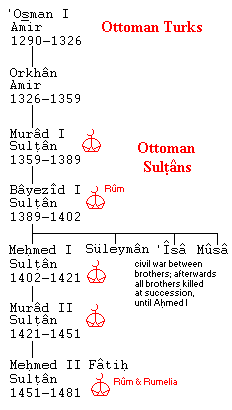
| Osmanli Oghullarļ | |
|---|---|
| 'Osman I | 1290-1326 |
| defeats Romans near
Nicomedia, Ottoman conquest begins, 1302; Seljuks overthrown, 1307; Bursa [Prusa] taken, 1326 | |
| Orkhān | 1326-1359 |
| defeats Andronicus III, 1329; I.znik [Nicaea] taken, 1331; I.zmid [Nicomedia] taken, 1337; Gelibolu [Kallipolis] taken, 1354; Ankara [Angora] taken, 1354 | |
| Murād I | 1359-1389 |
| Edirne [Adrianople] taken, 1369; Konya [Iconium] taken, 1387; Thessalonica taken, 1387; battle of Kosovo, "Field of the Blackbirds," Sult.ān killed defeating Serbs, 1389 | |
| Bāyezīd I Yļldļrļm, the "Thunderbolt" |
1389-1402 |
| seige of Constantinople, 1394-1402; Battle of Nicopolis, Sigismund of Hungary defeated, 1396; Battle of Ankara, Sult.ān defeated, captured & imprisoned by Tamerlane, 1402 | |
| Meh.med I | 1402-1421 |
| Civil War, 1402-1413, between Meh.med, Süleymān, & Mūsā; Thessalonica ceded to Romania, 1403 | |
| Murād II | 1421-1451 |
| Seige of Constantinople, 1422; Thessalonica captured from Venice, 1430 | |
| Meh.med II Fātih. the "Conqueror" | 1451-1481 |
| I.stanbul [Constantinople] taken, 1453; conquest of Bosnia, 1463; Khanate of Crimea becomes a Vassal, 1475; Seige of Rhodes repulsed, 1480 | |
| Bāyezīd II | 1481-1512 |
| Selīm I Yavuz, "the Grim" |
1512-1520 |
| Conquest of Syria and Egypt, 1516-1517 | |
| Süleymān I, the Magnificent | 1520-1566 |
| Fall of Rhodes, 1523; Battle of Mohįcs, Conquest of Hungary, death of Louis II of Hungary & Bohemia, 1526; First Siege of Vienna, 1529; Conquest of Mesopotamia, 1534; Appeal arrives from Sult.ān of Acheh for aid against the Portuguese, 1563; Siege of Malta, 1565 | |
| Selīm II | 1566-1574 |
| Peace of Adrianople, tribute from Austria, 1568; conquest of Cyprus, 1571; Battle of Lepanto, naval defeat by Spain, Venice, & Malta, 1571 | |
| Murād III | 1574-1595 |
| inconclusive war with Austria, 1593-1606 | |
| Meh.med III | 1595-1603 |
| Ah.med I | 1603-1617 |
| Mus.t.afā I | 1617-1618 |
| 'Osmān II | 1618-1622 |
| Ah.med I (restored) | 1622-1623 |
| Murād IV | 1623-1640 |
| Ibrāhīm | 1640-1648 |
| Meh.med IV | 1648-1687 |
| Naval defeat by Venice & Malta at Dardanelles, 1656; War with Austria, 1663-1664; Conquest of Crete from Venice, 1669; Second Siege of Vienna, 1683; Austrian conquest of Hungary, 1686-1697 | |
| Süleymān II | 1687-1691 |
| Parthenon destroyed in explosion, 1687 | |
| Ah.med II | 1691-1695 |
| Mus.t.afā II | 1695-1703 |
| Russia takes Azov, 1696; Loss of Hungary, 1697; Peace of Karolwitz, 1699 | |
| Ah.med III | 1703-1730 |
| Recovery of Azov, 1711; War with Austria, 1716-1718; Loss of Banat, Serbia, & Little Wallachia, 1716-1718; Peace of Passarowitz, 1718 | |
| Mah.mud I | 1730-1754 |
| War with Austria, Recovery of Serbia & Wallachia, 1737-1739; Peace of Belgrade, 1739 | |
| 'Osmān III | 1754-1757 |
| Mus.t.afā III | 1757-1774 |
| 'Abdül-H.amīd I | 1774-1789 |
| Russian conquest of Crimea, 1774-1783 | |
| Selīm III | 1789-1807 |
| Odessa annexed by Russia, 1791; Revolt of Serbs, 1804-1813; Russian invasion, occupation of Moldavia & Wallachia, 1806-1812; Sult.ān overthrown by Janissaries, 1807 | |
| Mus.t.afā IV | 1807-1808 |
| Mah.mūd II | 1808-1839 |
| Treaty of Bucharest, Russia ceded Bessarabia, 1812; Serbian autonomy, 1813; Greek Revolt, 1821-1829; Sult.ān massacres Janissaries, 1826; Russian invasion, occupation of Moldavia & Wallachia, 1828-1829; Treaty of Adrianople, Greek Independence, Danube Delta to Russia, autonomy of Moldavia & Wallachia, 1829 | |
| 'Abdül-Mejīd I | 1839-1861 |
| Crimean War, 1853-1856; Russian invasion, 1853; Britain, France, & Austria enter against Russia, 1854; Austria occupies Moldavia & Wallachia, 1854-1857; Siege of Sebastopol, 1854-1855; Peace of Paris, recovery of Danube Delta, Wallachia & Moldavia combined as Romania, with part of Bessarabia, 1856 | |
| 'Abdül-'Azīz | 1861-1876 |
| Revolts in Bosnia & Bulgaria, 1875-1876 | |
| Murād V | 1876 |
| 'Abdül-H.amīd II, "the Damned" | 1876-1909 |
| Russo-Turkish War, 1877-1878; Congress of Berlin, Serbia, Romania, & Montenegro Independent, Bulgaria autonomous, Bessarabia to Russia, Dobruja to Romania, Cyprus to Britain, Bosnia, Herzegovina & Novipazar, Austrian Protectorate, 1878; British Occupy Egypt, 1882; Bulgaria annexes East Rumelia, 1885; Revolt of the Young Turks, 1908, Sult.ān overthrown | |
| Meh.med V | 1909-1918 |
| First Balkan War, 1912-1913; Italy occupies Libya & the Dodecanese, 1912; Second Balkan War, recovery of Adrianople, 1913; World War I, 1914-1918 | |
| Meh.med VI | 1918-1922 |
| Armenian Republic conquered, 1920-1921; Greco-Turkish War, 1920-1922 | |
| 'Abdül-Mejīd II | Caliph only, 1922-1924 |
The historical and international image of the Turks does not seem to be the
most lovable or romantic. Most Americans probably are going to be more
sympathetic to people with historic grievances against Turkey -- Greeks,
Armenians, Romanians, Serbs, even Arabs.  The disappearance of all the ancient peoples of Anatolia, from the
Phrygians and Galatians to the Isaurians, and the sad Fall of Constantinople,
now combines with lingering outrage over the genocide of the Armenians
during World War I -- an event that Turkey still officially
and stoutly denies, despite thorough historical documentation,
not to mention many surviving eyewitnesses -- and more recent actions against
the Kurds. Not long ago it was a crime in Turkey to assert, even on the floor of
the parliament, that there even were Kurds in the country -- and in 1994
four members of parliament were sentenced to 15 years in prison for
giving speeches in Kurdish. Although responding in some ways to European demands
for human rights improvements before being considered for admission to the
European Union, since December 2001 the Turkish government has officially
regarded Kurdish given names as "terrorist propaganda" and refused to register
them for Kurdish children. With all this, one does not even need to see the very
hostile, anti-Turkish movie Midnight Express [1978].
The disappearance of all the ancient peoples of Anatolia, from the
Phrygians and Galatians to the Isaurians, and the sad Fall of Constantinople,
now combines with lingering outrage over the genocide of the Armenians
during World War I -- an event that Turkey still officially
and stoutly denies, despite thorough historical documentation,
not to mention many surviving eyewitnesses -- and more recent actions against
the Kurds. Not long ago it was a crime in Turkey to assert, even on the floor of
the parliament, that there even were Kurds in the country -- and in 1994
four members of parliament were sentenced to 15 years in prison for
giving speeches in Kurdish. Although responding in some ways to European demands
for human rights improvements before being considered for admission to the
European Union, since December 2001 the Turkish government has officially
regarded Kurdish given names as "terrorist propaganda" and refused to register
them for Kurdish children. With all this, one does not even need to see the very
hostile, anti-Turkish movie Midnight Express [1978].
In historical perspective, however, it is not clear to what extent the ancient peoples even still existed by the time of the Turkish arrival. Greek assimilation, i.e. Hellenization, of Anatolian peoples had been progressing steadily for centuries, and Turkish settlement in comparison doesn't necessarily look all that different. Given the religious cause that they thought they were vindicating (for which Islām usually seems more excused than Christianity), the Fall of Constantinople, far from sad, was one of the supreme moments of achievement in the history of Islām. A Western, or a modern liberal, evaluation will not give that much weight, but it is not hard to imagine that the sensation it created in Islām was not much different from that in Christendom at the capture of Jerusalem by the First Crusade, or the completion of the Reconquista in Spain. These are similarly denigrated by modern opinion, but it is hard to imagine how the values at the time could have been different -- everyone should guard against an anachronistic indignation.
The subsequent Ottoman Empire features the goods and evils characteristic of most empires, and some peculiar to those of the Middle East -- e.g. the refuge provided for Spanish Jews in 1492, as against the slavery and forced conversion of Christian children for the Janissary corps. Evils specific to nationalism emerged later, like the aforementioned genocide of Armenians and the continuing suppression of the Kurds, an Iranian people who happen to be Orthodox Moslems like the Turks. The Turks are not uniquely at fault for this, and the solution is a kind of society (liberal and capitalistic) upon which few in the world entirely agree, even in the ethnic plurality of societies like the United States. Turkey now has an especially tough time with its own identity as it is torn between the Islamic fundamentalist revival seen elsewhere and the secularism that Kemal Atatürk made the foundation of the modern state in the 1920's. None of this may make Turkey particularly lovable, but it does make the Turks mostly like anybody else, with a history that has its horrors but, indeed, also its own bit of romance and magnificience: a desire to surpass Sancta Sophia (still called Aya Sofya in Turkish, after the Greek version of the name, Hagia Sophia) produced a series of some of the most beautiful mosques in Islām, which have inspired much of subsequent Islāmic architecture (the standard doomed mosque, starting with Muh.ammad 'Alī's Alabaster Mosque in Cairo) [note].
Today one of the sights of Istanbul is the Fatih Camii (Fātih.
Jāmi-i), the "Conqueror's Mosque." This contains the tomb of Meh.med II,
with a dedicated mosque, school, hospice, and (formerly) caravansaray. It stands
on the site of the Church of the Holy Apostles, which was the burial place of
the Emperor Constantine and
subsequent Emperors of Romania. Already largely in ruins in 1453, it is not
clear what the fate of all the Imperial burials was -- they may actually have
simply been covered over by the later construction, the way the Imperial mosaics
in Sancta Sophia were simply whitewashed, preserving them for modern display. A
great deal of Roman Constantinople actually survives underground and invisible
in modern Istanbul. What the Church of the Holy Apostles probably looked like
can still be seen in a probable copy, St. Mark's in Venice.
 At Meh.med II's death, the Ottoman Empire looked much the way
Romania had in the 11th Century. Selīm I "the Grim" did what the old Emperors
had never been able to do, restore Syria and Egypt to the empire (from the Mamlūks). Süleimān I then
added areas that had never been permanent parts of the Roman Empire, Iraq and
Hungary. Picking up the Roman conflict with Irān, the Turks for the
first time since Alexander
the Great removed Iraq from Iranian possession (the map shows the pre-Safavid Aq Qoyunlu or White Sheep Turks). The
conquest of Hungary
was the first penetration of Islām into Francia since the conquest of Spain.
At Meh.med II's death, the Ottoman Empire looked much the way
Romania had in the 11th Century. Selīm I "the Grim" did what the old Emperors
had never been able to do, restore Syria and Egypt to the empire (from the Mamlūks). Süleimān I then
added areas that had never been permanent parts of the Roman Empire, Iraq and
Hungary. Picking up the Roman conflict with Irān, the Turks for the
first time since Alexander
the Great removed Iraq from Iranian possession (the map shows the pre-Safavid Aq Qoyunlu or White Sheep Turks). The
conquest of Hungary
was the first penetration of Islām into Francia since the conquest of Spain.

 The Ottoman Empire was at its height for about 150 years. It had at
that point, however, reached the limits beyond which it could not easily project
its power. Conflict continued with Austria and with Christian powers in the
Mediterranean, but respective holdings didn't change much. The Sult.ān Ah.mad
Mosque, or the Blue Mosque, adjacent to the site of the old Hippodrome of
Constantinople, is a fitting symbol of the achievement and confidence of this
period. The long delayed fall of Crete in 1669 then seemed like the portent of
renewed conquests. The energetic Köprülü vizirs planned a new assault, after 150
years, against Vienna in 1683. But this turned into a disaster, suddenly
revealing the relative weakness that had actually overcome the Empire. Even a
de facto alliance with friendly France, the greatest power of the day,
could not prevent a series of defeats, the loss of Hungary, and the temporary
loss of southern Greece to Venice.
The Ottoman Empire was at its height for about 150 years. It had at
that point, however, reached the limits beyond which it could not easily project
its power. Conflict continued with Austria and with Christian powers in the
Mediterranean, but respective holdings didn't change much. The Sult.ān Ah.mad
Mosque, or the Blue Mosque, adjacent to the site of the old Hippodrome of
Constantinople, is a fitting symbol of the achievement and confidence of this
period. The long delayed fall of Crete in 1669 then seemed like the portent of
renewed conquests. The energetic Köprülü vizirs planned a new assault, after 150
years, against Vienna in 1683. But this turned into a disaster, suddenly
revealing the relative weakness that had actually overcome the Empire. Even a
de facto alliance with friendly France, the greatest power of the day,
could not prevent a series of defeats, the loss of Hungary, and the temporary
loss of southern Greece to Venice.
It is noteworthy at this point that Ottoman Sult.āns ceased to murder their
brothers on accession. Henceforth the Throne passes, by Middle Eastern custom,
to brothers and even to cousins before going to the next generation. 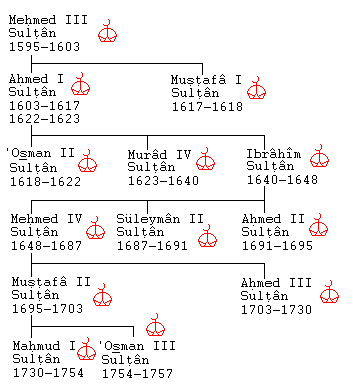
The threat of continuous defeat, which the beginning of the 18th century
seemed to display, receded somewhat. Austria would not advance deeper into the
Balkans and there was some breathing room. Nevertheless, the Ottomans were now
facing the problem of catching up with the technological advances of Europe,
even of relatively backward Russia, which it was in no way prepared to tackle.
The problem was not any particular hostility to modern commercial culture --
merchants and markets were perfectly respectable characteristics of Middle
Eastern Islāmic civilization -- but a very profound social conservativism, a
satisfaction with the Mediaeval forms of life, prevented any of this from
developing into modern institutions of banking, industry, and entrepreneurship.
Like the Chinese, the Turks literally did not believe there was anything new to
learn, much less from despised Unbelievers. The bustle and excitement of the
great Istanbul Bazaar thus never led to the explosion of energy and production
that was already characteristic of the Netherlands and other places in Western
Europe. Turkey would always be playing catch-up but would then never actually
catch up. Institutional reforms, when they were even tried, still could never go
deep enough, could never actually produce a people striving and inquisitive
beyond their previous habits. Peter the Great faced
similar problems with another conservative society about the same time.
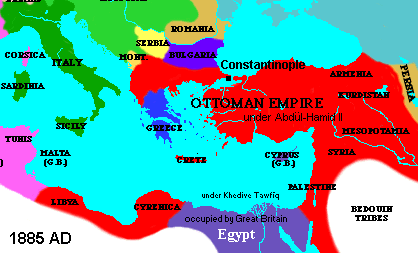
At the beginning of the 19th century, as Napoleon surged back and forth across Europe, the subject Christians of the Balkans became more and more restless, and Russia began to try again and again to retrieve Constantinople for Christendom and break through the Straits. The Ottomans, although achieving some successes, were not going to be able to resist this. The Empire's status as the "Sick Man of Europe" was now becoming quite established. It was Realpolitik that came to the rescue of the Sult.ān: Britain did not want Russia to be too successful and so entered into a long policy of supporting the Turks against the forces, from Russia or Egypt or wherever, that might result in the collapse of Ottoman rule. Nevertheless, Britain could not allow too much oppression of subject Christians, and as the century wore on, small Christian states, from Serbia to Greece to Bulgaria, were allowed autonomy and then independence by the agreement of the Great Powers. This did not get any of them all they wanted, and it certainly limited Russian gains, but it kept the geo-political dam from bursting and kept the Sult.ān from falling off his Throne.
Finally, it was the internal forces of Turkey that began to shake things up
after a pattern that would become all too familiar in "underdeveloped" countries
later: A military coup, the "Young Turks," against the detested Sult.ān
'Abdül-Hamīd II in 1908. 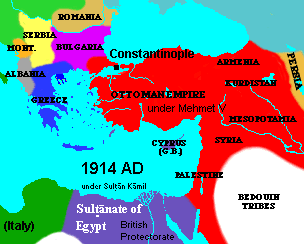 This did not help much when the Balkan states fell on Turkey in
1912. The choice of Germany as a European ally would then be fatal for the
Ottoman future. Another ill effect was the transformation of the Mediaeval Cause
of Islām into a more modern Turkish nationalism. This did not work well, and
never would, with the Arabs, Armenians, and Kurds living within Turkish borders.
The disaffection of the first exploded in a pro-Allied revolt in World War I.
Suspicion about the second led to shameful deportation and massacre about the
same time. And conflict with the third continues, with campaigns of terrorism
and suppression, even today. Woodrow Wilson impotently
called for an independent Armenia state, in an area where there were by then few
Armenians left, and soon almost none after Turkey pushed the Armenian Republic
back east of the Araks (Aras) River in 1920. No Power has called for an
independent Kurdish state. Meanwhile, the British and French were perfectly
happy to detach the Arab lands from the Empire, not for independence, to be
sure, but to further British and French imperial projects. This turned out to be
more trouble than it was worth, especially when the Zionist colonization of
Palestine, allowed by the British, led to the creation of Israel and to a conflict,
including five major wars (1948, 1956, 1967, 1973, 1982), that continues until
today. The settlement of World War I has thus been aptly called "the peace to
end all peace."
This did not help much when the Balkan states fell on Turkey in
1912. The choice of Germany as a European ally would then be fatal for the
Ottoman future. Another ill effect was the transformation of the Mediaeval Cause
of Islām into a more modern Turkish nationalism. This did not work well, and
never would, with the Arabs, Armenians, and Kurds living within Turkish borders.
The disaffection of the first exploded in a pro-Allied revolt in World War I.
Suspicion about the second led to shameful deportation and massacre about the
same time. And conflict with the third continues, with campaigns of terrorism
and suppression, even today. Woodrow Wilson impotently
called for an independent Armenia state, in an area where there were by then few
Armenians left, and soon almost none after Turkey pushed the Armenian Republic
back east of the Araks (Aras) River in 1920. No Power has called for an
independent Kurdish state. Meanwhile, the British and French were perfectly
happy to detach the Arab lands from the Empire, not for independence, to be
sure, but to further British and French imperial projects. This turned out to be
more trouble than it was worth, especially when the Zionist colonization of
Palestine, allowed by the British, led to the creation of Israel and to a conflict,
including five major wars (1948, 1956, 1967, 1973, 1982), that continues until
today. The settlement of World War I has thus been aptly called "the peace to
end all peace."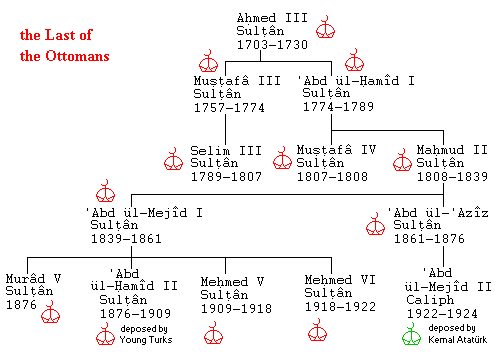

The
spelling of the names of the Ottomans is intended to indicate both the Turkish
pronunciation and how they are spelled in Arabic (which no longer matters, since
Turkish is no longer written in the Arabic alphabet, but is of historical
interest). Here I have pretty much followed the usage of the Cambridge
History of Islam. A good example is the name of the Conqueror of
Constantinople, Meh.med II. This name is Muh.ammad in Arabic but
is actually pronounced Mehmet in Turkish. Obviously, some compromises are
made and the system is not perfect. In general, the consonants look Arabic and
the vowels Turkish. Since Turkish (and Persian) reads the Arabic alphabet with
three s's (Arabic s, s., and th) and four z's
(Arabic z, z., d., and dh), some attempt is made to
differentiate (e.g. with s for th). Modern Turkish writes
c for English j and ē for English ch, but the
English equivalents are used here.
The main reason that Arabic writing did not work well for Turkish was the
Turkish vowel system. Where Classical Arabic  had three short and three long vowels, and Persian
had three short and three long vowels, and Persian  could match its six vowels with those, Turkish has eight vowels, as
shown at left (in the official Romanization). The most intriguing thing about
Turkish vowels is the system of vowel harmony. Related Ural-Altaic
languages, like Mongolian and
even Hungarian
(though some dispute the reality of the Ural-Altaic family, or even the Altaic
family, or whether Korean and Japanese are Altaic
members), also have vowel harmony, but this seems to appear in Turkish in its
most complete, logical, and elegant form. The rules are simply, (1) front vowels
are followed by front vowels (e.g. i by e), back vowels by back vowels (e.g. u
by a), (2) unrounded vowels are followed by unrounded vowels (e.g. i by e), and
(3) rounded vowels are followed by high rounded (e.g. o by u) or low unrounded
vowels (e.g. o by a). There are Turkish grammatical inflections in which the
vowel is supposed to be simply either high or low, with its character otherwise
determined by the preceding vowels in the word. This all was impossible to show
in the Arabic alphabet without a special notation that might have been developed
but, evidently, never was. There are many words in Turkish that violate vowel
harmony, but by this they can be identified as foreign loan words -- for example
islām (instead of *islem), from Arabic, and istanbul
(instead of *istenbil), from Greek or Arabic.
could match its six vowels with those, Turkish has eight vowels, as
shown at left (in the official Romanization). The most intriguing thing about
Turkish vowels is the system of vowel harmony. Related Ural-Altaic
languages, like Mongolian and
even Hungarian
(though some dispute the reality of the Ural-Altaic family, or even the Altaic
family, or whether Korean and Japanese are Altaic
members), also have vowel harmony, but this seems to appear in Turkish in its
most complete, logical, and elegant form. The rules are simply, (1) front vowels
are followed by front vowels (e.g. i by e), back vowels by back vowels (e.g. u
by a), (2) unrounded vowels are followed by unrounded vowels (e.g. i by e), and
(3) rounded vowels are followed by high rounded (e.g. o by u) or low unrounded
vowels (e.g. o by a). There are Turkish grammatical inflections in which the
vowel is supposed to be simply either high or low, with its character otherwise
determined by the preceding vowels in the word. This all was impossible to show
in the Arabic alphabet without a special notation that might have been developed
but, evidently, never was. There are many words in Turkish that violate vowel
harmony, but by this they can be identified as foreign loan words -- for example
islām (instead of *islem), from Arabic, and istanbul
(instead of *istenbil), from Greek or Arabic.
In the first book I had about Turkish, Teach Yourself Books, Turkish
[St. Paul's House, Warwick Lane, London, 1953, 1975], the author, G.L. Lewis,
specifically ridicules Hagopian's Ottoman-Turkish Conversation-Grammar of
1907 because, out of 215 pages, it  devoted 161 to Arabic and Persian [p.vi]. Well, I have gone to some
trouble to get a copy of Hagopian's Ottoman-Turkish Conversation-Grammar,
and it is a very fine book. The section on Arabic and Persian is very much as
though every English grammar book came along with Donald M. Ayers' English
words from Latin and Greek elements [University of Arizona Press, 1986],
which I encountered as the textbook for a popular class at the University of
Texas on the Greek and Latin contributions to English. As it happens, of course,
fewer and fewer American students are even taught English grammar, much
less enough Greek or Latin to understand or appreciate its use of them. This not
a virtue. Nor is the nationalistic enthusiasm that seeks to purge languages of
"foreign" words, which has happened in Turkish, German, French, Hungarian, and
elsewhere. This kind of thing is simply an attempt to purge history itself --
along with a ugly attempt to sharpen ethnic identities and differences.
devoted 161 to Arabic and Persian [p.vi]. Well, I have gone to some
trouble to get a copy of Hagopian's Ottoman-Turkish Conversation-Grammar,
and it is a very fine book. The section on Arabic and Persian is very much as
though every English grammar book came along with Donald M. Ayers' English
words from Latin and Greek elements [University of Arizona Press, 1986],
which I encountered as the textbook for a popular class at the University of
Texas on the Greek and Latin contributions to English. As it happens, of course,
fewer and fewer American students are even taught English grammar, much
less enough Greek or Latin to understand or appreciate its use of them. This not
a virtue. Nor is the nationalistic enthusiasm that seeks to purge languages of
"foreign" words, which has happened in Turkish, German, French, Hungarian, and
elsewhere. This kind of thing is simply an attempt to purge history itself --
along with a ugly attempt to sharpen ethnic identities and differences.
Later, Geoffrey Lewis appears to have thought better of his ridicule. Subsequently editions of Teach Yourself Turkish cut down on the dismissive remarks; and recently Lewis has published The Turkish Language Reform, A Catastrophic Success [Oxford, 1999, 2002]. Here we learn about the artificial coinages, supposedly "true" Turkish, and the confusion that has now alienated modern Turkey from its own heritage, the best of Ottoman literature. Indeed, the writings of Kemal Atatürk himself have needed more than once to be "translated" into New(er) Turkish. At a literary or technical level usage still sometimes shifts between an Arabic word, a "Turkish" neologism, or French, just to make sure that everyone can recognize one of the words. Lewis's own Turkish Grammar [Oxford, 1967, 2000] provides information to enable people to read the Ottoman language. It probably is too late to deliberately go back, but, like German returning to Telefon from Fernsprecher, perhaps Turkish usage will drift back to more of its Persian and Arabic heritage.
| Turkish Republic, 1923; Presidents | |
|---|---|
| Mustafa Kemal, (1934) Atatürk |
1923-1938 |
| Ismet Inönü | 1938-1950 |
| France cedes Alexandretta & Antioch, 1939 | |
| Celal Bayar | 1950-1960 |
| Kemal Gürcel | 1961-1966 |
| Cevdet Sunay | 1966-1973 |
| Fahri Korutürk | 1973-1980 |
| Kenan Evren | 1980-1989 |
| Turgut Özal | 1989-1993 |
| Süleyman Demirel | 1993-2000 |
| Ahmet Necdet Sezer | 2000-2007 |
| Abdullah Gül | 2007 |
 who adopted the surname Atatürk, "Father of the Turks." With no
concessions to Greeks, Armenians, or Kurds, Atatürk nevertheless abandoned most
imperial aspirations. Giving up the Arabic alphabet and traditional costume
(indeed, making their use even a capital offense), deposing the Ottomans, and
otherwise trying to make Turkey a European, rather than a Middle Eastern, state,
Atatürk simply hoped to make it the equal of other modern powers. To a
considerable extent he succeeded, though Turkey is still haunted by the shadow
of the military dictatorship that he himself represented, by the threat of
militant Islām, whose mediaevalism is fully triumphant in neighboring Irān, and
by the disaffection of the Kurds, whose very existence was legally denied for
many years. Nevertheless, it is undoubtedly the strongest state in the region,
to the chagrin of neighboring Arabs and Christians alike. Long a member of NATO,
Turkey looks foward to membership in the European Community, but still has
little embarrassments like the common use of torture by police. Thus, despite
Atatürk, we still have several respects in which Turkey is posed between East
and West, Mediaeval and Modern, Islām and secularism, liberalism and oppression.
The application of Turkey to the European Union has been defered, but will be
considered in a couple of years.
who adopted the surname Atatürk, "Father of the Turks." With no
concessions to Greeks, Armenians, or Kurds, Atatürk nevertheless abandoned most
imperial aspirations. Giving up the Arabic alphabet and traditional costume
(indeed, making their use even a capital offense), deposing the Ottomans, and
otherwise trying to make Turkey a European, rather than a Middle Eastern, state,
Atatürk simply hoped to make it the equal of other modern powers. To a
considerable extent he succeeded, though Turkey is still haunted by the shadow
of the military dictatorship that he himself represented, by the threat of
militant Islām, whose mediaevalism is fully triumphant in neighboring Irān, and
by the disaffection of the Kurds, whose very existence was legally denied for
many years. Nevertheless, it is undoubtedly the strongest state in the region,
to the chagrin of neighboring Arabs and Christians alike. Long a member of NATO,
Turkey looks foward to membership in the European Community, but still has
little embarrassments like the common use of torture by police. Thus, despite
Atatürk, we still have several respects in which Turkey is posed between East
and West, Mediaeval and Modern, Islām and secularism, liberalism and oppression.
The application of Turkey to the European Union has been defered, but will be
considered in a couple of years.The term of Turkish President Ahmet Necdet Sezer ended on 16 May 2007, but a
new President was not elected until August. The most likely candidate and
eventual President, Abdullah Gül, from an Islamic Party 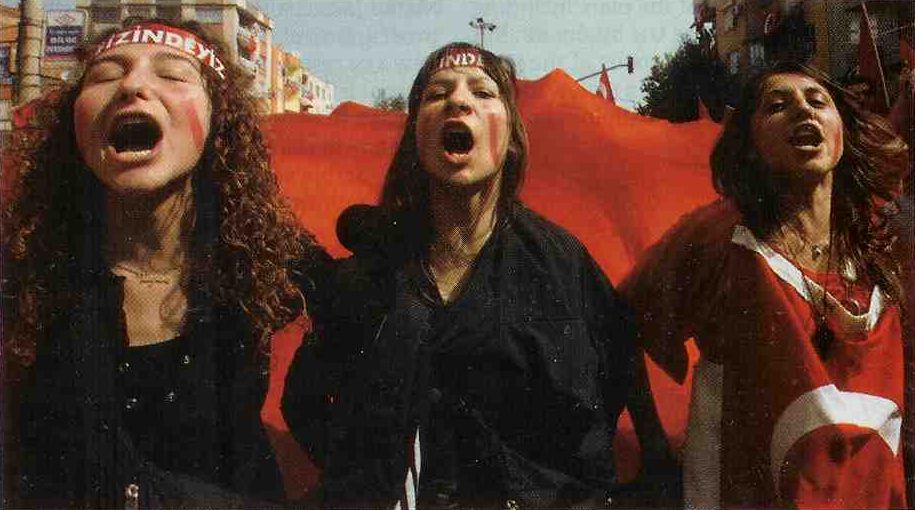 (and with a wife who wears a headscarf), drew wide protest
from everyone who wished to preserve the secular nature of the Turkish Republic.
There was even a warning from the Army, which has deposed the government four
times since 1960, that it may not tolerate any compromise to Atatürk's ideal of
secular government. The Islamic threat would seem to justify the reluctance of
the European Union to expedite the admission of Turkey, an attitude that some
Turks regard as simple racism. However, the defeat of the Islamic forces in
Turkey should remove some European reservations. The actual election of Gül
leaves all these issues rather up in the air.
(and with a wife who wears a headscarf), drew wide protest
from everyone who wished to preserve the secular nature of the Turkish Republic.
There was even a warning from the Army, which has deposed the government four
times since 1960, that it may not tolerate any compromise to Atatürk's ideal of
secular government. The Islamic threat would seem to justify the reluctance of
the European Union to expedite the admission of Turkey, an attitude that some
Turks regard as simple racism. However, the defeat of the Islamic forces in
Turkey should remove some European reservations. The actual election of Gül
leaves all these issues rather up in the air.
A discussion of general sources for this material is given under Francia and Islām. Some additional sources
include The Penguin Historical Atlas of Russia (John Channon with Rob
Hudson, 1995), and various prose histories, such as The Ottoman Centuries
(Lord Kinross, Morrow Quill, 1977).
The Shihābī Amīrs of Lebanon, 1697-1842 AD
The House of Muh.ammad 'Alī in Egypt, 1805-1953 AD
The Sanūsī Amīrs & Kings of Libya, 1837-1969 AD
Not all who deny the existence of the Armenian genocide are Turkish, as I learned from e-mail recently. Anyone sincerely sceptical or confused about the matter should consult Death by Government (Transaction Publishers, New Brunswick, New Jersey, 1995, pp.209-239), by R.J. Rummel, one of the greatest living experts on mass murder. Rummel estimates the number of Armenians murdered in the main organized genocide program (there were others), from 1915-1918, as 1,404,000 persons. Some of the eyewitness testimony to this included reports by the American Ambassador to Turkey, Henry Morgenthau, Sr. (whose son, Henry Morgenthau, Jr., would be Franklin Roosevelt's Secretary of the Treasury), and by other American consular officials, at a time when the United States was still neutral in World War I. Morgenthau's account was published in 1919 as Ambassador Morgenthau's Story.
Nor should we disparage the endless pornographic fantasies that revolve
around the Harīm of the Sult.ān's Topkapļ Palace. 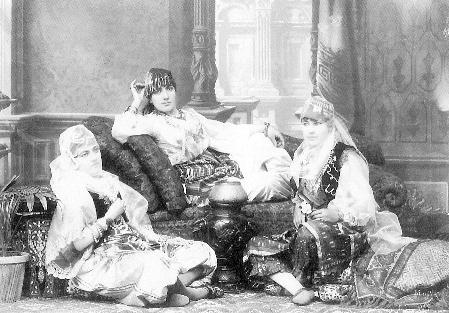 Fascination with this is now often disparaged as "Orientalism," i.e.
the projection of unrelated and hostile imaginings onto misunderstood
institutions; but there is no doubt of the extraordinary and bizarre
characteristics of the Imperial Harīm. If it was diverting for the Sult.ān, I
don't see why it should not continue to be so to the curious modern. An honest
and informed treatment of this can be found in Harem, The World Behind the
Veil [Abbeville Press, New York, London, Paris, 1989], by a woman who grew
up in Turkey, Alev Lytle Croutier, many of whose own relatives had lived in
traditional harīms. The books contains photographs from the Ottoman era
(including her relatives) as well as historical drawings and the sort of lush
and sensual paintings by Western artists that infuriate the anti-"Orientalism"
crowd. The image above is a 19th century photograph. It is given by Croutier
[p.74], but I also remember it from many years ago in Time magazine, at
the time that the Topkapļ Harīm was first opened to the public.
Fascination with this is now often disparaged as "Orientalism," i.e.
the projection of unrelated and hostile imaginings onto misunderstood
institutions; but there is no doubt of the extraordinary and bizarre
characteristics of the Imperial Harīm. If it was diverting for the Sult.ān, I
don't see why it should not continue to be so to the curious modern. An honest
and informed treatment of this can be found in Harem, The World Behind the
Veil [Abbeville Press, New York, London, Paris, 1989], by a woman who grew
up in Turkey, Alev Lytle Croutier, many of whose own relatives had lived in
traditional harīms. The books contains photographs from the Ottoman era
(including her relatives) as well as historical drawings and the sort of lush
and sensual paintings by Western artists that infuriate the anti-"Orientalism"
crowd. The image above is a 19th century photograph. It is given by Croutier
[p.74], but I also remember it from many years ago in Time magazine, at
the time that the Topkapļ Harīm was first opened to the public.
| The Shihābī Amīrs of Lebanon | |
|---|---|
| Bashīr I | 1697-1707 |
| H.aydar | 1707-1732 |
| Mulh.im | 1732-1754 |
| Mans.ūr | 1754-1770 |
| Yūsuf | 1770-1788 |
| first Maronite Amīr, 1770 | |
| Bashīr II | 1788-1840 |
| overthrown by Britain & Turkey, 1840 | |
| Bashīr III | 1840-1842 |
| direct Turkish Rule, 1842-1918; French Rule, 1920-1943 | |
| Republic of Lebanon | |
| Bishara al-Khuri | President, 1943-1952 |
| Camille Chamoun | 1952-1958 |
| Fuad Chehab | 1958-1964 |
| Charles Hélou | 1964-1970 |
| Sulayman Franjieh | 1970-1976 |
| Elias Sarkis | 1976-1982 |
| Amin Gemayel | 1982-1988 |
| Selim al-Huss | 1988-1989 |
| Elias Hrawi | 1989-1998 |
| Émile Lahoud | 1998-present |
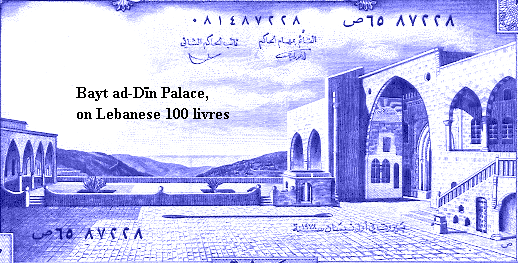 The Israelis, who invaded Lebanon in 1982 to get rid of the
Palestinians, more or less accomplished that task, with the PLO leaving for
Tunisia, but then discovered, as the Syrians had already, that the communal
rivalries of the Lebanese themselves, especially with the Shi'tes adopting
Iranian suicide and terror tactics, made the place a tar baby for any outsiders
who wanted to exert control by force. With the foreign powers chasened, the
Lebanese began to patch things up with some needed political compromises; and as
the 1990's progressed, some peace and prosperity seemed to be returning to the
country. It remains to be seen, however, if a modus vivendi can be found
to produce another golden age of communal alliance against the outside.
The Israelis, who invaded Lebanon in 1982 to get rid of the
Palestinians, more or less accomplished that task, with the PLO leaving for
Tunisia, but then discovered, as the Syrians had already, that the communal
rivalries of the Lebanese themselves, especially with the Shi'tes adopting
Iranian suicide and terror tactics, made the place a tar baby for any outsiders
who wanted to exert control by force. With the foreign powers chasened, the
Lebanese began to patch things up with some needed political compromises; and as
the 1990's progressed, some peace and prosperity seemed to be returning to the
country. It remains to be seen, however, if a modus vivendi can be found
to produce another golden age of communal alliance against the outside.
Maronite Patriarchs of Lebanon
Egypt was abruptly pulled into modern history with the invasion of Napoleon in 1798. Although Egypt had been conquered by the Turks in 1517, the strange slave dynasty of the Mamlūks had continued and by Napoleon's time had reestablished de facto authority in the declining Empire. After the French were driven from Egypt in 1801, Muh.ammad 'Alī arrived, supposedly to reėstablish Turkish authority.
Brilliant, ruthless, farsighted, and probably the most important Albanian in world history, Muh.ammad 'Alī very quickly established his own authority instead. The final Mamlūks were massacred in 1811, and Muh.ammad 'Alī moved to create a modern state, and especially a modern army, for Egypt. In this he was as successful as any non-European power at the time. By the time the Greeks revolted against Turkey in 1821, it was Muh.ammad 'Alī who turned out to have the best resources to put down the revolution and was called on by the Sult.ān in 1824 to do so. He very nearly did, until Britain intervened and sank the Egyptian fleet at the Battle of Navarino in 1827. Frustrated in that direction, Muh.ammad 'Alī was successful in his conquest of the Sudan (1820-1822), probably advancing further up the Nile than any power since Ancient Egypt, though at a terrible cost to the Sudanese in massacre, mutilations, and slaving (of which the American boxer Cassius Clay was probably unaware when he adoped the name "Muhammad Ali" upon his conversion to Islām). Egyptian interventions in Arabia in 1818-1822 and 1838-1843 very nearly exterminated the House of Sa'ūd and its fundamentalist Wahhābī movement, which much later would create a united and independent Sa'ūdī Arabia.
| The House of Muh.ammad 'Alī in Egypt | |
|---|---|
| Muh.ammad 'Alī | Pasha, 1805-1848 |
| Ibrāhīm | 1848 |
| 'Abbās H.ilmī I | 1848-1854 |
| Muh.ammad Sa'īd | 1854-1863 |
| Suez Canal Started, 1859 | |
| Ismā'īl | 1863-1867 |
| Khedive, 1867-1879, d. 1895 | |
| Suez Canal Opened, 1869 Britain buys Khedive's share in Canal, 1875 | |
| Muh.ammad Tawfīq | 1879-1892 |
| British Occupation, 1882 | |
| 'Abbās H.ilmī II | 1892-1914, d. 1944 |
| British Protectorate, 1914-1922 | |
| H.usayn Kāmil | Sult.ān, 1914-1917 |
| Ah.mad Fu'ād I | 1917-1922 |
| King, 1922-1936 | |
| Fārūq | 1936-1952, d. 1965 |
| Ah.mad Fu'ād II | 1952-1953 |
| Republic of Egypt, 1953- | |
| Muhammad Naguib | President, 1953-1954 |
| Gamal Abdel Nasser | 1954-1970 |
| Anwar as-Sadat | 1970-1981 |
| Mohammed Hosni Mubarak |
1981-present |
The most formative subsequent event for Egyptian history was certainly the construction of the Suez Canal. Although Britain had nothing to do with the project, and it was the French Emperor Napoleon III who attended the lavish opening ceremonies, the collapse of Egyptian financies led to the purchase by Britain of all Egypt's shares in the Canal Company. This did not solve Egypt's financial problems, which got worse. The Khedive Ismā'īl also wasted resources on disastrous campaigns against Ethiopia in 1875-1876. With its interests now in danger, Britain occupied Egypt, without French support, in 1882. Ironically, the Occupation was undertaken under Prime Minister William Gladstone, who was opposed to British Imperialism. He was not, however, going to endanger British finances just because the Khedive didn't know how to handle his.
This made Egypt a de facto part of the British Empire, indeed one of the most important parts, with the Suez Canal an essential strategic link between Britain and India. Some of the most colorful episodes in British Imperial history occured because of this. In 1881 a revolt had started in the Sudan, led by a man claiming to be the Apocalyptic Mahdī of Islāmic tradition. Gladstone was not going to spend British money, or Egyptian, in trying to suppress the rebellion. Consequently, Charles Gordon, known as "Chinese Gordon" for his part in putting down the Taiping Rebellion in China (1860-1864), and who had already been governor-general of the Sudan from 1877-1880, was sent back in order to evacuate the Egyptian garrison. Once there, he decided to stay and resist the Mahdī. By 1885 this insubordination stirred up public opinion back home and forced Gladstone to send a relief expedition; but it missed rescuing Gordon by two days, as the Mahdī's forces overran Khartoum and killed Gordon. This made Gordon one of the great heroes of the day, humiliated Britain, and resulted in the fall of Gladstone's government. However, the Sudan was, for the time being, abandoned. When the British returned in 1898, in the heyday of imperial jingoism, Lord Kitchener, with a young Winston Churchill along, calmly massacred the mediaeval army of the Mahdī's successor at the Battle of Omdurman, avenged Gordon, and made himself one of the immortal heroes of the British Empire too. Although formally in Egyptian service, Kitchener reconquered the Sudan as an Anglo-Egyptian "condominium." The theory of British and Egyptian joint rule in the Sudan continued until Sudanese independence in 1956, though between 1924 and 1936 the British didn't even allow Egyptian forces or authorities into the Sudan.
 All this took place with Egypt still legally part of the Ottoman
Empire. Right down until 1914 the Turkish flag was dutifully flown and Turkish
passports issued. When Turkey repaid a century of British support by throwing
its lot with Germany in World War I, however, the fiction came to an end, and
Egypt de jure came under British rule as a Protectorate, with the
Sult.ānate, abolished by the Turks in 1517, reėstablished. This was not
popular in Egypt, and after the war Egypt did become a formally independent
Kingdom. However, the British did retain Treaty rights to garrison and
protect the Suez Canal; so, in many ways, the British Occupation of 1882 simply
continued. There was little doubt of that once World War II started. Egypt, a
legally Neutral country, was first invaded by Italy and then by Germany, with
British forces meeting, fighting, and ultimately expelling them. Egypt at the
time seemed no less a part of the British Empire than it had ever been. Egypt
did eventually declare war on Germany, but not until February 24, 1945.
All this took place with Egypt still legally part of the Ottoman
Empire. Right down until 1914 the Turkish flag was dutifully flown and Turkish
passports issued. When Turkey repaid a century of British support by throwing
its lot with Germany in World War I, however, the fiction came to an end, and
Egypt de jure came under British rule as a Protectorate, with the
Sult.ānate, abolished by the Turks in 1517, reėstablished. This was not
popular in Egypt, and after the war Egypt did become a formally independent
Kingdom. However, the British did retain Treaty rights to garrison and
protect the Suez Canal; so, in many ways, the British Occupation of 1882 simply
continued. There was little doubt of that once World War II started. Egypt, a
legally Neutral country, was first invaded by Italy and then by Germany, with
British forces meeting, fighting, and ultimately expelling them. Egypt at the
time seemed no less a part of the British Empire than it had ever been. Egypt
did eventually declare war on Germany, but not until February 24, 1945.
The end of Muh.ammad 'Alī's dynasty resulted from the humiliation of
continuing British occupation, the mortification of Egyptian failure in the war
against Israeli independence in 1948, and from the failure of King Fārūq,
who was rather more successful as a playboy than as a leader, to deal with any
of it. The army, soon led by Gamal Abdel Nasser, swept away the monarchy,
got British forces to leave Egypt, and then won a great political victory when
Britain and France (74 years late) reoccupied the Canal, Israel invaded the
Sinai, and both the United States and the Soviet Union told them all to leave in
no uncertain terms, in the Suez Crisis of 1956 (just as Soviet tanks were
rolling into Hungary!). Thus, Egypt became a player in the Cold War, and
the heritage of Muh.ammad 'Alī, the Ottoman Empire, and British imperialism
faded rapidly.
| The Sanūsī Amīrs & Kings of Libya | |
|---|---|
| Muh.ammad as-Sanūsī | 1837-1859, Cyrenaica, 1841 |
| Muh.ammad al-Mahdī | 1859-1902 |
| Ah.mad ash-Sharīf | 1902-1916, d.1933 |
| Italian occupation, 1911 | |
| Muh.ammad Idrīs | 1916-1949; Amir, 1949-1951; King, 1951-1969, d.1983 |
| Muammar Qaddafi dictatorship, 1969-present | |
This was a thinly populated backwater for the Turks, noteworthy mainly for Roman ruins and piracy (with U.S. Marines landing at Tripoli in 1801). It all achieved greater significance when Italy displaced the Ottomans in 1911 (ceded in 1912). Indeed, Libya became one of the most important strategic theaters of World War II. The Italians tried invading Egypt from Libya in September 1940 but by February 1941 had been thrown completely out of Cyrenaica, with 130,000 soldiers captured. Alarmed, Hitler sent Erwin Rommel with a couple of divisions to prevent the Italian position from collapsing completely. Rommel, however, went on the offensive. For more than a year, things surged back and forth, with Cyrenaica recovered, lost, and recovered again. By July 1942, Rommel was deep into Egypt, barely stopped at El Alamein, 60 miles from Alexandria. By then, however, the United States was in the War; and the strongly reinforced British began an offensive in October. They broke through and soon swept the Germans and Italians entirely out of Libya. Retreating into Tunisia, they were caught against the Americans who had landed in Morocco and Algeria in November.
After the War, Libya formally became independent in 1951, under the Sasūnī
Amīr of Cyrenaica. The long lived King Idrīs was eventually overthrown in 1969.
This was under the leadership of the erratic and megalomaniacal Muammar Qaddafi.
Along with armed clashes with Egypt and Chad,  Libya became a sponsor of terrorism. Blamed for a bombing in Berlin
in 1986, Libya was bombed by Ronald Reagan in retaliation.
Later blamed for a bomb that brought down Pam Am Flight 103 over Lockerbie,
Scotland in 1988, sanctions were imposed on Libya until accused operatives were
surrendered. This eventually happened, Qaddafi may have thought better of his
ways, and sanctions were lifted in 2003. Meanwhile, Qaddafi had dressed up his
dictatorship with an idiosyncratic political theory. Libya became the "Great
Socialist People's Libyan Arab Jamahiriya." Jamahiriya, similar to the
Arabic word for "republic," jumhūrīya, was a term coined by Qaddafi for
his political system, which was supposed to be a kind of direct, mass democracy,
but is probably no more democratic than similar arrangements in the Soviet
Union. Like Mao's little red book, Qaddafi produced a little green book. Qaddafi
seems secure enough, like many other dictators (one thinks of Castro), but
increasingly anachronistic (Castro, again).
Libya became a sponsor of terrorism. Blamed for a bombing in Berlin
in 1986, Libya was bombed by Ronald Reagan in retaliation.
Later blamed for a bomb that brought down Pam Am Flight 103 over Lockerbie,
Scotland in 1988, sanctions were imposed on Libya until accused operatives were
surrendered. This eventually happened, Qaddafi may have thought better of his
ways, and sanctions were lifted in 2003. Meanwhile, Qaddafi had dressed up his
dictatorship with an idiosyncratic political theory. Libya became the "Great
Socialist People's Libyan Arab Jamahiriya." Jamahiriya, similar to the
Arabic word for "republic," jumhūrīya, was a term coined by Qaddafi for
his political system, which was supposed to be a kind of direct, mass democracy,
but is probably no more democratic than similar arrangements in the Soviet
Union. Like Mao's little red book, Qaddafi produced a little green book. Qaddafi
seems secure enough, like many other dictators (one thinks of Castro), but
increasingly anachronistic (Castro, again).

"Romania" means the area in the Balkans and Middle East with successor states to the Mediaeval Roman Empire that was neither part of historic "Francia" (the land of the "Franks" to those in Islām), which means Western, Central, and Northern Europe originally subject to the Latin, Roman Catholic Church in Rome, nor part of historic Russia in Eastern Europe, subject to the Russian Orthodox Church.
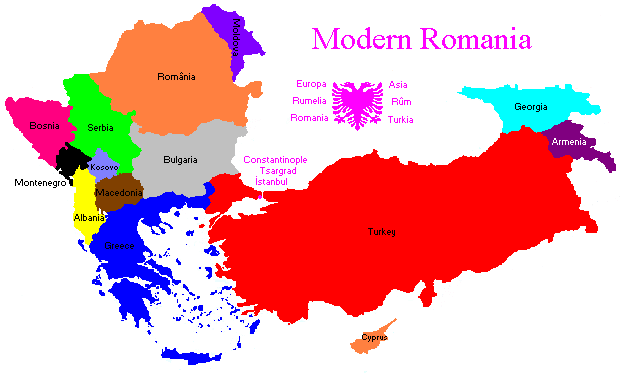
This will be an unfamiliar use of the name "Romania" for most, and the reason
for it is explained in "Decadence, Rome and Romania, the
Emperors Who Weren't, and Other Reflections on Roman History," "The Vlach Connection and Further
Reflections on Roman History," and the "Guide and Index to Lists of
Rulers." The double headed eagle of the Palaeologi symbolized the
European and Asian sides of the Empire. This now represents a significant
historical and cultural divide. The Asian side, and the center of the Empire at
Adrianople and Constantinople, is still largely Turkish. This is a rather
different Turkey from the Ottoman Empire, however, secularized and Westernized
by Kemal Atatürk, with things like the Arabic alphabet actually outlawed, now
hoping to join the European Union. On the European side, the successor states to
Rome in the 12th and 13th centuries have reemerged. This is also the case to the
east, where Georgia and
Armenia, kept from the Ottomans 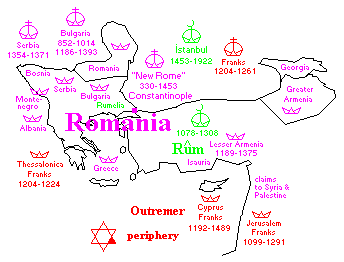 by Russia, are now independent.
by Russia, are now independent.
Thus, "Modern Romania" here means the modern successor states, first to Rome ("Romania" to itself, "Byzantium" to the historians), second to the Ottoman Empire, which in the 14th and 15th centuries established its domination over all former Roman possessions, and more, in the Eastern Mediterranean. As the Roman successors emerged in the 12th century, so do the Ottoman successors emerge in the 19th century. Familiar states from the earlier period are Serbia, Bulgaria, Cyprus, and even Bosnia. The earlier states of the Vlach speaking Romanians, Wallachia and Moldavia, continue from the past, subject to special achievements in Ottoman misrule, ultimately to unite as the modern state of Romānia, the only country in Europe to preserve the proper name of the Roman Empire. Turkey is still the largest and most powerful state in the region.
Entirely new states are Montenegro and Greece itself. Montenegro, the "Black Mountain" (Qara Dagh in Turkish and Crna Gora in Serbo-Croatian), like many remote areas of the Ottoman Empire, began to drift out of central control as Turkish power went into its long decline. "Greece" itself was something that, in a sense, didn't exist in the Middle Ages. What the Ancient Greeks had called themselves, "Hellenes," came to be used in Late Roman times to mean Greek pagans. Greek Christians were "Romans," Rhōmaioi in Greek. This distinction was maintained through the Middle Ages, and was remembered well into the 19th, if not the 20th, century (a Greek can still be Rum in Turkish). A modern Greece, Hellas, that was not an heir to Rome, was an entirely new phenomenon.
The politically, religiously, and culturally dominant language of Mediaeval
Romania was  Greek, whose alphabet today, however, is only used in Greece. For the
same period the
Greek, whose alphabet today, however, is only used in Greece. For the
same period the  Armenian alphabet was in use by Armenians both in Romania and in the
often separate kingdoms of Armenia. Under the Ottomans,
Armenian alphabet was in use by Armenians both in Romania and in the
often separate kingdoms of Armenia. Under the Ottomans,
|
|
||
| Europa | 1. Romania | 2. Constantinople |
| 2. Francia | 1. Rome | |
| 3. Russia | 3. Moscow | |
 Georgians dates from the same era as the Armenian, and now continues
to be used in the former Soviet Republic of Georgia. Both the Armenian and the
Georgian alphabets, although based on Greek, have their own striking and
distinctive styles. The conversion of the Slavs resulted in the introduction of
a new alphabet, the
Georgians dates from the same era as the Armenian, and now continues
to be used in the former Soviet Republic of Georgia. Both the Armenian and the
Georgian alphabets, although based on Greek, have their own striking and
distinctive styles. The conversion of the Slavs resulted in the introduction of
a new alphabet, the  Cyrillic, which has remained the alphabet of choice for Slavs who
belong to Orthodox Churches, like the Serbs, Bulgarians, and Russians. When
modern Romanian (Vlach) first began to be written, it also used the Cyrillic
alphabet, but eventually both Romanian and Albanian (also for many centuries
unwritten) were rendered in the
Cyrillic, which has remained the alphabet of choice for Slavs who
belong to Orthodox Churches, like the Serbs, Bulgarians, and Russians. When
modern Romanian (Vlach) first began to be written, it also used the Cyrillic
alphabet, but eventually both Romanian and Albanian (also for many centuries
unwritten) were rendered in the  Latin alphabet, which thus came to be used for spoken languages in
the Balkans for the first time since Latin speaking Roman colonists, and the
Imperial Court in Constantinople, would have used it many centuries earlier.
Since one's alphabet usually went with one's religion in the Middle Ages, the
Turks, and other local converts to Islām, used the
Latin alphabet, which thus came to be used for spoken languages in
the Balkans for the first time since Latin speaking Roman colonists, and the
Imperial Court in Constantinople, would have used it many centuries earlier.
Since one's alphabet usually went with one's religion in the Middle Ages, the
Turks, and other local converts to Islām, used the  Arabic alphabet; and Jews, especially Jews arriving after Spain
expelled them in 1492, used the
Arabic alphabet; and Jews, especially Jews arriving after Spain
expelled them in 1492, used the  Hebrew alphabet. We have already seen some exceptions to the
religion rule, however. Orthodox Christian Churches could be found using
different alphabets, Greek, Armenian, and Cyrillic (as well as, more distantly,
Coptic, Syriac, and Ethiopic), which already had introduced an ethnic or
national dimension to the issue. This is also evident when the Orthodox
Romanians and the largely Moslem Albanians
Hebrew alphabet. We have already seen some exceptions to the
religion rule, however. Orthodox Christian Churches could be found using
different alphabets, Greek, Armenian, and Cyrillic (as well as, more distantly,
Coptic, Syriac, and Ethiopic), which already had introduced an ethnic or
national dimension to the issue. This is also evident when the Orthodox
Romanians and the largely Moslem Albanians 
 turn to the Latin alphabet, neither with the slightest intention of
entering into religious communion with Papal Roman (i.e. Frankish) Catholicism.
The Turks themselves, directed by Kemal Atatürk, followed suit. The Jews of
Turkey also fell into this, and it became possible to find Ladino, the language
of the 15th century Jewish refugees from Spain, being written in 20th century
Istanbul synagogues using the Turkish version of the Latin alphabet.
turn to the Latin alphabet, neither with the slightest intention of
entering into religious communion with Papal Roman (i.e. Frankish) Catholicism.
The Turks themselves, directed by Kemal Atatürk, followed suit. The Jews of
Turkey also fell into this, and it became possible to find Ladino, the language
of the 15th century Jewish refugees from Spain, being written in 20th century
Istanbul synagogues using the Turkish version of the Latin alphabet.  Thus the ancient prestige of Latin Rome, and the modern
dominance of Latinate Francia, has exerted itself in modern Romania over
Orthodox Christianity, Islām, and Judaism -- even while the old Hebrew alphabet
is now used for Hebrew revived as a spoken language in modern Israel.
Thus the ancient prestige of Latin Rome, and the modern
dominance of Latinate Francia, has exerted itself in modern Romania over
Orthodox Christianity, Islām, and Judaism -- even while the old Hebrew alphabet
is now used for Hebrew revived as a spoken language in modern Israel.
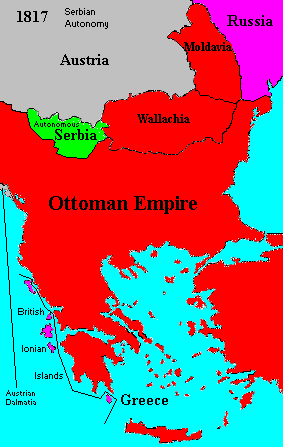 A characteristic of imperial states is an easy mixing of peoples
and languages. They all have too much to fear from the imperial power for too
much trouble to develop between them. When the heavy imperial hand is withdrawn,
however, serious trouble can result. Thus, the end of the British Empire resulted in the
partitions, amid war and massacre, of India, Palestine, and Cyprus. The decline
of Turkish power similarly uncorked more than a century of conflict, continuing
even in 2000, in the Balkans. Border areas end up with the most ambiguous
identities and so can provoke the greatest conflict. Bosnia and
Herzegovina, which had been swapped back and forth between Hungary and
Romania and Serbia in the 12th and 13th centuries, and then were long held by
the Turks, ended up with a mixed population of Croats (Latin/Catholic
Christians), Serbs (Orthodox Christians), and Moslem Bosnians (Bosniacs). All,
as it happened, spoke the same language, Serbo-Croatian, but written in
different alphabets. The disintegration of Yugoslavia, with the lifting of the
heavy imperial hand of Communism in the 1990's, led to terrible fighting,
massacres, and atrocities, most famously carried out by the Serbs against the
others, but not unheard of from the Croatians, Bosniacs, and Kosovar Albanians
also. A famous bridge in Mostar in Herzegovina, which had linked, actually and
symbolically, the Christian and Moslem parts of the city, was destroyed
(evidently by Croatians) in the fighting. With a peace settlement patched up for
Bosnia, the Serbs then turned their hand against the restless Albanian majority
of Kosovo, which the Serbs regarded as the Serbian heartland but which had
contained few Serbs for a long time. It is enough to make one yearn for the
return of the Palaeologi. The first map
above shows the situation in 1817, after the Russo-Turkish War of 1806-1812,
rebellions by Serbia, and a final grant of autonomy to Serbia. The Ionians
Islands had originally belonged to Venice but were seized by Britain in the
Napoleonic Era and ceded to Britain by the Congress of Vienna.
A characteristic of imperial states is an easy mixing of peoples
and languages. They all have too much to fear from the imperial power for too
much trouble to develop between them. When the heavy imperial hand is withdrawn,
however, serious trouble can result. Thus, the end of the British Empire resulted in the
partitions, amid war and massacre, of India, Palestine, and Cyprus. The decline
of Turkish power similarly uncorked more than a century of conflict, continuing
even in 2000, in the Balkans. Border areas end up with the most ambiguous
identities and so can provoke the greatest conflict. Bosnia and
Herzegovina, which had been swapped back and forth between Hungary and
Romania and Serbia in the 12th and 13th centuries, and then were long held by
the Turks, ended up with a mixed population of Croats (Latin/Catholic
Christians), Serbs (Orthodox Christians), and Moslem Bosnians (Bosniacs). All,
as it happened, spoke the same language, Serbo-Croatian, but written in
different alphabets. The disintegration of Yugoslavia, with the lifting of the
heavy imperial hand of Communism in the 1990's, led to terrible fighting,
massacres, and atrocities, most famously carried out by the Serbs against the
others, but not unheard of from the Croatians, Bosniacs, and Kosovar Albanians
also. A famous bridge in Mostar in Herzegovina, which had linked, actually and
symbolically, the Christian and Moslem parts of the city, was destroyed
(evidently by Croatians) in the fighting. With a peace settlement patched up for
Bosnia, the Serbs then turned their hand against the restless Albanian majority
of Kosovo, which the Serbs regarded as the Serbian heartland but which had
contained few Serbs for a long time. It is enough to make one yearn for the
return of the Palaeologi. The first map
above shows the situation in 1817, after the Russo-Turkish War of 1806-1812,
rebellions by Serbia, and a final grant of autonomy to Serbia. The Ionians
Islands had originally belonged to Venice but were seized by Britain in the
Napoleonic Era and ceded to Britain by the Congress of Vienna.
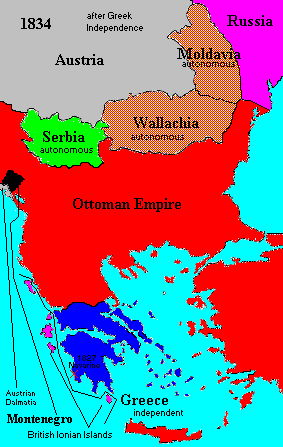 My source for the king lists was originally the
Kingdoms of Europe, by Gene Gurney [Crown Publishers, New York, 1982].
Gurney has some errors and obscurities, but I have not found any other work that
has put so much together in one volume. It is a shame that his list of the
Princes of Wallachia and Moldavia is incomplete, but it also looks like it would
be a very long list, since the Turks changed Princes frequently, and in earlier
periods the succession may be imperfectly known. Recent heads of state are
largely from the Regentenlisten und Stammtafeln zur Geschichte Europas by
Michael F. Feldkamp [Philipp Reclam, Stuttgart, 2002]. Feldkamp has a more
complete treatment of Wallachia and Moldavia, but, unfortunately, only prior to
the era shown here. The maps are based on The Penguin Atlas of Recent History
(Europe since 1815) (Colin McEvedy, 1982), The Anchor Atlas of World
History, Volume II (Hermann Kinder, Werner Hilgemann, Ernest A. Menze, and
Harald and Ruth Bukor, 1978), The Penguin Historical Atlas of Russia
(John Channon with Rob Hudson, 1995), and various prose histories, such as
The Ottoman Centuries (Lord Kinross, Morrow Quill, 1977).
My source for the king lists was originally the
Kingdoms of Europe, by Gene Gurney [Crown Publishers, New York, 1982].
Gurney has some errors and obscurities, but I have not found any other work that
has put so much together in one volume. It is a shame that his list of the
Princes of Wallachia and Moldavia is incomplete, but it also looks like it would
be a very long list, since the Turks changed Princes frequently, and in earlier
periods the succession may be imperfectly known. Recent heads of state are
largely from the Regentenlisten und Stammtafeln zur Geschichte Europas by
Michael F. Feldkamp [Philipp Reclam, Stuttgart, 2002]. Feldkamp has a more
complete treatment of Wallachia and Moldavia, but, unfortunately, only prior to
the era shown here. The maps are based on The Penguin Atlas of Recent History
(Europe since 1815) (Colin McEvedy, 1982), The Anchor Atlas of World
History, Volume II (Hermann Kinder, Werner Hilgemann, Ernest A. Menze, and
Harald and Ruth Bukor, 1978), The Penguin Historical Atlas of Russia
(John Channon with Rob Hudson, 1995), and various prose histories, such as
The Ottoman Centuries (Lord Kinross, Morrow Quill, 1977).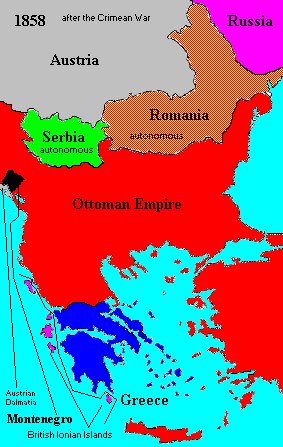
The two maps, just above and to the right, show the situation (1) after the War of Greek Independence (1821-1829) and (2) after the Crimean War (1853-1856). To save Greece, all the Great Powers were drawn in against Turkey.
With Greek independence went increased territory for Serbia, autonomy for Wallachia and Moldavia, and border concessions to Russia.
In the Crimean War, Britain and France joined Turkey against Russia, with
much of the fighting taking place, as one might expect from the name, in the
Crimea. This pretty much preserved the status quo for Turkey, though the borders
were extended against Russia along the Black Sea. One change we see, however,
was the unification of Wallachia and Moldavia into the state of Romānia.
| 1. ROMĀNIA | |||
|---|---|---|---|
| Continued from "Rome and Romania," "Romanians" | |||
| WALLACHIA | MOLDAVIA | ||
| Radu Mihnea | Voivode, Prince, Governor, 1611-1616, 1623-1626 | ||
| Leon Tomsa | 1629-1632 | Miron Barnovschi Movila |
Voivode, Prince, Governor, 1626-1629, 1633 |
| Matei Basarab | 1632-1654 | Vasie Lupu | 1634-1653 |
| Constantine Serban |
1654-1658 | ||
| Grigore Ghica | 1660-1664 | ||
| Serban Cantacuzino |
1678-1688 | ||
| Constantine Brancoveeanu |
1688-1714 | Constantine Cantemir |
1685-1693 |
| Phanariot Greek Tax Farming | |||
| 1716-1717, 1719-1730 |
Nicholas Mavrocordat | 1711-1714 | |
| Stephen Cantacuzino |
1714-1716 | ||
| 1741-1744 | Michael Racovita | 1717-? | |
| 1735-1741, 1744-1748 |
Gregoy Ghica | 1726-1733, 1774-1777 | |
| Constantine Mavrocordat | 1741-1743, ?-1769 | ||
| Russian right of
intervention, Treaty of Kuchuk Karinarji, 1774 | |||
| Alexander Ypsilanti |
1774-1782 | Alexander Moruzi |
?-1806 |
| Constantine Ypsilanti |
1802-1806 | ||
| Russian Occupation, 1806-1812 | |||
| John Caragea | 1812-1818 | Scarlat Calimah | 1812-1819 |
| Alexander Sutu | 1818-1821 | ||
| Russian Occupation,
1828-1834; Governor Count Kisselev | |||
| Alexander Ghica | 1834-1842 | Mihai Sturdza | 1834-1849 |
| Georghe Bibescu | 1842-1848 | ||
| Revolution in Wallachia, 1848; Russian Occupation, 1848-1851; Crimean War, 1853-1856; Russian Occupation, 1853-1854; Austrian Occupation, 1854-1857 | |||
| Alexander John Cuza of Moldavia | 1859-1866 | ||
| Charles Eitel Frederick of Hohenzollern-Sigmaringen, Carol I |
1866-1881 | ||
| King, 1881-1914 | |||
| Russo-Turkish War, 1876-1878; Russian Invasion, Romania proclaimed independent, 1877; Congress of Berlin, Romania Independent, 1878 | |||
| Ferdinand | 1914-1927 | ||
| Michael | 1927-1930, 1940-1947 | ||
| Carol II | 1930-1940 | ||
| Ion Antonescu, pro-German dictator | 1940-1944 | ||
| Communist takeover, 1947 | |||
| Constantin Parhon | President, 1948-1952 | ||
| Petru Groza | 1952-1958 | ||
| Ion Georghe Maurer | 1958-1961 | ||
| Georghe Georghiu-Dej | 1961-1965 | ||
| Chivu Stoica | 1965-1967 | ||
| Nicolae Ceauēescu | 1967-1989, executed | ||
| Ion Iliescu | 1989-1996, 2000-present | ||
| Emil Constantinescu | 1996-2000 | ||
The Principalities of Wallachia and Moldavia have a continuous
institutional history back to the 14th Century, which means that this table
simply continues the table begun on the Rome and Romania page.  Turkish rule, however, led to the practice of the appointment of
Greek tax farmers, the Phanariots (from the Phanar section of Istanbul), as
Princes. Their job was simply to get as much money out of the land as possible,
both for the Sublime Porte (the Ottoman government) and for themselves (the
reason to be a tax farmer). This was not good, or popular, for the
Principalities, but not much could be done about it until Russian power began to
be felt in the region. The Russian wars against Turkey in the 19th Century led
several times to the occupation of Wallachia and Moldavia. After the Crimean War
(18453-1856) and, for a change, Austrian occupation (1854-1857), and a bad
experience with a local candidate for rule of the unified country, a European
prince, as in Greece and Bulgaria,
Turkish rule, however, led to the practice of the appointment of
Greek tax farmers, the Phanariots (from the Phanar section of Istanbul), as
Princes. Their job was simply to get as much money out of the land as possible,
both for the Sublime Porte (the Ottoman government) and for themselves (the
reason to be a tax farmer). This was not good, or popular, for the
Principalities, but not much could be done about it until Russian power began to
be felt in the region. The Russian wars against Turkey in the 19th Century led
several times to the occupation of Wallachia and Moldavia. After the Crimean War
(18453-1856) and, for a change, Austrian occupation (1854-1857), and a bad
experience with a local candidate for rule of the unified country, a European
prince, as in Greece and Bulgaria, 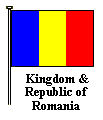 was brought in, Karl of Hohenzollern. The Congress of Berlin
recognized Karl (Carol) and Romanian independence (1878). With the Allies in
World War I, winning Transylvania from Hungary and Moldova from Russia --
Romania was the biggest long term winner of the War in the Balkans -- Romania,
after much internal strife, switched to the Axis in World War II, losing Moldova
to the Soviet Union (seized in 1940, actually, before Romania was a belligerent)
and part of Dobruja to Bulgaria. While Moldova is now independent, I have not
noticed any discussion of reunion with Romania.
was brought in, Karl of Hohenzollern. The Congress of Berlin
recognized Karl (Carol) and Romanian independence (1878). With the Allies in
World War I, winning Transylvania from Hungary and Moldova from Russia --
Romania was the biggest long term winner of the War in the Balkans -- Romania,
after much internal strife, switched to the Axis in World War II, losing Moldova
to the Soviet Union (seized in 1940, actually, before Romania was a belligerent)
and part of Dobruja to Bulgaria. While Moldova is now independent, I have not
noticed any discussion of reunion with Romania.
Rejecting the Cyrllic alphabet and the Turkish influenced "Rumania" (or
"Roumania") for  the Latin alphabet and the pure Latin Romānia, Romania can
now claim that name as its own, with few remembering that it was the proper name
of the Roman (and the "Byzantine") Empire. In the Middle Ages, "Romania" tended
to refer to the contemporaneous extent of the Empire, i.e. Anatolia and the
Balkans ("Asia and Europa" or "Rūm and Rumelia"). The modern state might be said
to be "Lesser Romania" in contrast to that "Greater Romania"; but this might be
considered insulting by Romanians (though intentionally no more so than "Lesser Armenia" in
Cilicia) and so is not likely to catch on.
the Latin alphabet and the pure Latin Romānia, Romania can
now claim that name as its own, with few remembering that it was the proper name
of the Roman (and the "Byzantine") Empire. In the Middle Ages, "Romania" tended
to refer to the contemporaneous extent of the Empire, i.e. Anatolia and the
Balkans ("Asia and Europa" or "Rūm and Rumelia"). The modern state might be said
to be "Lesser Romania" in contrast to that "Greater Romania"; but this might be
considered insulting by Romanians (though intentionally no more so than "Lesser Armenia" in
Cilicia) and so is not likely to catch on.
The mysterious history of Romance speakers in the Balkans, the Romanians and
Vlachs, whose existence is not noticed until the 12th Century and whose language
is not attested until the 16th, is treated separated in "The Vlach Connection and Further
Reflections on Roman History." This is a story now charged with the
nationalism both of Romania and neighbors like Hungary.
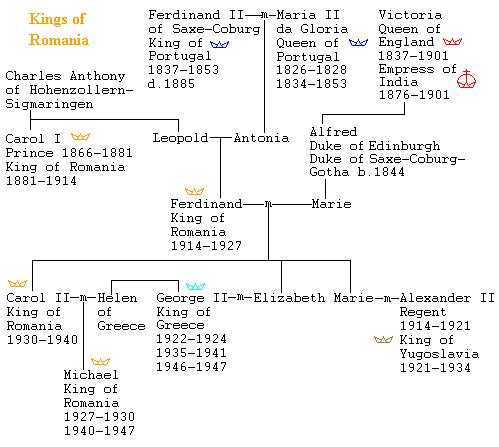 The marriages of the Romanian Royal Family quickly connected it to
major European, especially British and Greek, royalty. Thus King Ferdinand was
the grandson of a first cousin of Queen Victoria and Prince Albert (Ferdinand of
Portugal, the brother of Augustus, Prince of Coburg, who was the father of
Ferdinand of Bulgaria),
and he married one of their own granddaughters, Marie of Saxe-Coburg-Gotha. King
Carol II then married Helen of Greece, who was a
great-granddaughter of Queen Victoria, through her mother Sophia, the sister of
Kaiser Wilhlem II of Germany. All these
connections, of course, profited the monarchy little in the conflicts of fascism
and communism that had the country under one form of dictatorship or another
from 1940 to 1989.
The marriages of the Romanian Royal Family quickly connected it to
major European, especially British and Greek, royalty. Thus King Ferdinand was
the grandson of a first cousin of Queen Victoria and Prince Albert (Ferdinand of
Portugal, the brother of Augustus, Prince of Coburg, who was the father of
Ferdinand of Bulgaria),
and he married one of their own granddaughters, Marie of Saxe-Coburg-Gotha. King
Carol II then married Helen of Greece, who was a
great-granddaughter of Queen Victoria, through her mother Sophia, the sister of
Kaiser Wilhlem II of Germany. All these
connections, of course, profited the monarchy little in the conflicts of fascism
and communism that had the country under one form of dictatorship or another
from 1940 to 1989.
The two maps above show the situation before and after the Russo-Turkish War of 1877-1878. Note that by then Britain had ceded the Ionians Islands to Greece (1864). In 1875 rebellions started in Bosnia and then Bulgaria. The brutality with which these were suppressed aroused European opinion, and after some delay Russia declared war. With some hard fighting, the Russians ended up capturing Adrianople and arriving at the outskirts of Constantinople. The Treaty of San Stephano which ended the war mostly freed the Balkans, but the Great Powers didn't like it. The Congress of Berlin rolled things back a bit. Serbia, Romānia, and Montenegro all became independent, with increases in territory, but Bulgaria was divided and merely allowed autonomy. Bosnia, Herzegovina, and Novipazar were made protectorates of Austria. The map looked much the same for many years, with Bulgaria annexing East Rumelia in 1885.
| 2. MONTENEGRO | |
|---|---|
| Danilo I Petrovic | Prince-Bishop, 1697-1737 |
| Sava | 1737-1756 d.1782 |
| Vasili | Coadjutor, 1756-1766 |
| Stephen the Little |
Coadjutor, 1766-1774 |
| Sava | Coadjutor, 1774-1782 |
| Peter I | 1782-1830 |
| Peter II | 1830-1851 |
| Danilo II | 1851-1860 |
| Nicholas | 1860-1910 |
| King, 1910-1918, d.1921 | |
| Union with Yugoslavia,
1918; Independent, 3 June 3 2006 | |
| Filip Vujanovic | President, 2006-present |
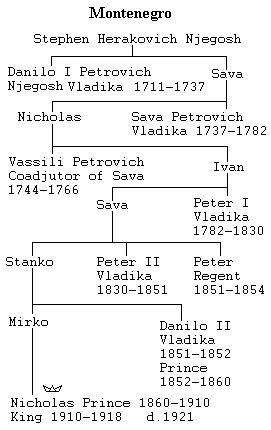
 Serbia's only access to the sea, through the historic port of Kotor
(Cattaro in Italian, obtained from Austria after World War I), the fear is that,
should the Montenegrans decide to go their own way, the Serbs would use force,
with enough local support to make resistance abortive.
Serbia's only access to the sea, through the historic port of Kotor
(Cattaro in Italian, obtained from Austria after World War I), the fear is that,
should the Montenegrans decide to go their own way, the Serbs would use force,
with enough local support to make resistance abortive.
Nevertheless, Montenegro voted for independence in 2006 and seems to have
successfully made the transition, recognized by many governments and admitted as
a member of the UN. This leaves Serbia as the last state in Yugoslavia.
 1908 was a big year in the Balkans. Bulgaria became independent
and Austria annexed most of its protectorate from the Congress of Berlin. In
Turkey, the Sultan, "Abdul the Damned," was overthrown by the Young Turks, whose
impetus, unfortunately, was more merely nationalistic than liberal. Meanwhile,
Greece was able to add Thessaly (1881, with adjustments in 1897). A rebellion on
Crete led to autonomy (1898) as a prelude to Greek control (1912).
1908 was a big year in the Balkans. Bulgaria became independent
and Austria annexed most of its protectorate from the Congress of Berlin. In
Turkey, the Sultan, "Abdul the Damned," was overthrown by the Young Turks, whose
impetus, unfortunately, was more merely nationalistic than liberal. Meanwhile,
Greece was able to add Thessaly (1881, with adjustments in 1897). A rebellion on
Crete led to autonomy (1898) as a prelude to Greek control (1912).
| 3. GREECE | |
|---|---|
| Greek War of Independence, 1821-1829 | |
| Alexander Ypsilanti | leads revolt, 1821-1828 |
| Treaty of London, Britain, France, & Russia support Greek independence, Battle of Navarino, Egyptian fleet sunk, 1827 | |
| Count Kapodistrias | regent, 1827-1830 |
| Russian War on Turkey, 1828-1829; Peace of Adrianople, 1829, London Conference, 1830, recognition of Greek Independence | |
| Otto of Bavaria | King, 1832-1862 |
| George I of Denmark | 1863-1913 |
| Constantine I | 1913-1917, 1920-1922 |
| Alexander | 1917-1920 |
| George II | 1922-1924, 1935-1941, 1946-1947 |
| Republic, 1924-1935 | |
| Pavlos Konduriotis | President, 1924-1926, 1926-1929 |
| Theodoros Pangalos | 1926 |
| Alexandros Zaimis | 1929-1935 |
| German Occupation, 1941-1944 | |
| Paul | 1947-1964 |
| Constantine II | 1964-1973, exile 1967 |
| Military Dictatorship, 1967-1974 | |
| Giorgios Zoitakis | 1967-1972 |
| Giorgios Papadopoulos | 1972-1973, President, 1973 |
| Phaidon Gizikis | 1973-1974 |
| Republic, 1974 | |
| Michael Stasinopoulos | 1974-1975 |
| Konstantin Tsatsos | 1975-1980 |
| Konstantin Karamanlis | 1980-1985, 1990-1995 |
| Christos Sartzetakis | 1985-1990 |
| Konstantin Stephanopoulos | 1995-present |
The revolt of Greece against the Turks was one of the sensations of the
19th century, drawing partisans,  like Lord Byron, from far and wide. Against the Ottomans alone, the
Greeks could well have been successful, but the Sultan called in Muh.ammad 'Alī, who had
modernized the Eyptian army enough that the rebellion was being suppressed. This
was too much, however, for "civilized" opinion. Not only the Russians, the
traditional protectors of Orthodox Christians in Turkey, but Britain and France,
inspired by all that Classical Oxbridge learning, moved to help the Greeks,
sinking Muh.ammad 'Alī's fleet at Navarino in 1827. They say that the ships are
still visible at the bottom of the bay, right by the island of Sphacteria, where
the Athenians defeated the Spartans early in the Peloponnesian War, and just
south of "Sandy Pylos," where a great Mycenaean city supplied wise Nestor to the
Greek forces at Troy.
like Lord Byron, from far and wide. Against the Ottomans alone, the
Greeks could well have been successful, but the Sultan called in Muh.ammad 'Alī, who had
modernized the Eyptian army enough that the rebellion was being suppressed. This
was too much, however, for "civilized" opinion. Not only the Russians, the
traditional protectors of Orthodox Christians in Turkey, but Britain and France,
inspired by all that Classical Oxbridge learning, moved to help the Greeks,
sinking Muh.ammad 'Alī's fleet at Navarino in 1827. They say that the ships are
still visible at the bottom of the bay, right by the island of Sphacteria, where
the Athenians defeated the Spartans early in the Peloponnesian War, and just
south of "Sandy Pylos," where a great Mycenaean city supplied wise Nestor to the
Greek forces at Troy.
The house of Denmark supplied most of the kings of modern Greece. The kingship itself contained an interesting ambiguity, since the Greek word basileus only meant "king" in Classical Greek. In mediaeval Greek, basileus was used by the Emperors of Romania to translate Latin imperator, i.e. "emperor." So which was it? Was the ruler of Greece merely the King of the Hellenes, or the Emperor of the Romans (Rhōmaioi)? When the Greeks tried to seize a large part of western Asia Minor from the Turks in 1920, it looked like restoring the Empire was the objective. Unfortunately, Turkey remained, and remains, fundamentally stronger than Greece, and the Greek invasion only provoked the expulsion of all Greeks from the mainland.
Politically,  Greece has swung back and forth in the 20th century. Whether the
monarchy was a good thing was often in doubt, as it was briefly abolished in the
20's and almost not reinstituted after World War II. Then the Army took over in
1967, creating a dictatorship that lasted until 1974. King Constantine II tried
to organize a counter-coup against the dictatorship, but then fled the country
when he failed. Eventually the dictators abolished the monarchy. When democracy
was restored, after a stupid attempt to overthrow the government of Cyprus
(provoking a Turkish invasion), the Greeks nevertheless seemed to think that
Constantine had not been sufficiently vigorous in opposing the dictatorship, so
the monarchy was not restored. Since then, Greece seems to have made a
speciality of electing anti-American, socialist governments, long after that
made any sense either geo-politically or economically. A good example of recent
foolishness was a nationwide strike on May 17, 2001, with 10,000 protesters
marching on the Parliament in Athens. Protesting what? Well, the Greek state
pension system is nearly bankrupt, and the Government is considering reforms,
like cutting benefits and increasing the retirement age (to 65). Even the
socialist government, however, might have anticipated the offense to the Greek
sense of entitlement that this would cause.
Greece has swung back and forth in the 20th century. Whether the
monarchy was a good thing was often in doubt, as it was briefly abolished in the
20's and almost not reinstituted after World War II. Then the Army took over in
1967, creating a dictatorship that lasted until 1974. King Constantine II tried
to organize a counter-coup against the dictatorship, but then fled the country
when he failed. Eventually the dictators abolished the monarchy. When democracy
was restored, after a stupid attempt to overthrow the government of Cyprus
(provoking a Turkish invasion), the Greeks nevertheless seemed to think that
Constantine had not been sufficiently vigorous in opposing the dictatorship, so
the monarchy was not restored. Since then, Greece seems to have made a
speciality of electing anti-American, socialist governments, long after that
made any sense either geo-politically or economically. A good example of recent
foolishness was a nationwide strike on May 17, 2001, with 10,000 protesters
marching on the Parliament in Athens. Protesting what? Well, the Greek state
pension system is nearly bankrupt, and the Government is considering reforms,
like cutting benefits and increasing the retirement age (to 65). Even the
socialist government, however, might have anticipated the offense to the Greek
sense of entitlement that this would cause.
This kind of thing was all bad enough, but then 60 Minutes reported (6
January 2002) that the Greek government, and especially the dominant Socialist
Party, appeared to be tolerating a radical leftist terrorist organization, "17
November," that had been responsible for bombings and murders for years. Not a
single member of this organization had been arrested or even identified by the
government, even though unmasked members raided a police station for weapons and
could easily have been described. When members of the Greek press were
threatened for reporting on the organization, and police closed the
investigations even of murder cases against them, one began to wonder if a sort
of leftist death squad had come into existence in Greece. This boded ill for the
future of Greece, not only economically, but even as a functioning democracy.
Now, however, this situation is looking up. Perhaps under pressure to straighten
things out if Greece wanted to host the 2004 Olympics, the government now has
arrested many members of "17 November," and the suspects have been spilling
details about the membership and operations of the organization [Los Angeles
Times, Wednesday, August 7, 2002, "Toppled From Their Pedestal"]. The actual
popularity of the group now has been damaged by the very willingness of its
members to inform and cooperate in order to avoid harder sentences. Happily, the
2004 Olympics came off without incident.
Although the Greek monarchy is now gone, the Greek Royal family remains
impressively connected to two of the most important centers of contemporary
European royalty. 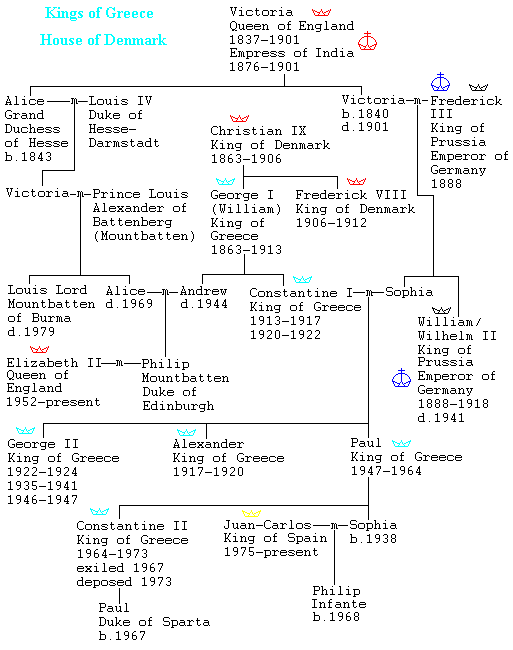 The heirs of the British monarchy are now all descendants, through
Prince Philip, of King George I of Greece; and all the Greek Royal Family itself
is descended from both Queen Victoria and the Emperor Frederick III of Germany.
Then Constantine II's sister Sophia married Juan Carlos of Spain, who was able
to do in Spain what Constantine wasn't able to in Greece -- restore democracy.
Now the heir of Spain, Philip (Filipe), is a descendant of Kings George,
Constantine I, and Paul of Greece. One might gather from this diagram that the
throne of Britain is due to pass the House of Denmark and Greece, or, more
precisely, the House of Schleswig- Holstein- Sonderburg- Glucksburg; but on
marrying Elizabeth, Prince Philip renounced his rights to the Greek throne and
his connection to the Greek Royal family, taking the name of his mother's
family, Battenberg/Mountbatten, so this connection is obscured. Now that royalty
is more a matter of international celebrity than of political power, Greece, by
blaming Constantine for a bunch of military dictators, is really missing out on
its share of space in People magazine. This may seem like an absurdly
trivial consideration, but Greece depends heavily on foreign tourism; and
foreign tourism depends heavily on international perception and publicity.
Space, free space, in People magazine means millions of dollars in
business for Greece. Instead, Greeks still have these ridiculous demonstrations
for socialism (not to mention the frightening terrorist activity) and nurse
their historic grievance against Turkey.
The heirs of the British monarchy are now all descendants, through
Prince Philip, of King George I of Greece; and all the Greek Royal Family itself
is descended from both Queen Victoria and the Emperor Frederick III of Germany.
Then Constantine II's sister Sophia married Juan Carlos of Spain, who was able
to do in Spain what Constantine wasn't able to in Greece -- restore democracy.
Now the heir of Spain, Philip (Filipe), is a descendant of Kings George,
Constantine I, and Paul of Greece. One might gather from this diagram that the
throne of Britain is due to pass the House of Denmark and Greece, or, more
precisely, the House of Schleswig- Holstein- Sonderburg- Glucksburg; but on
marrying Elizabeth, Prince Philip renounced his rights to the Greek throne and
his connection to the Greek Royal family, taking the name of his mother's
family, Battenberg/Mountbatten, so this connection is obscured. Now that royalty
is more a matter of international celebrity than of political power, Greece, by
blaming Constantine for a bunch of military dictators, is really missing out on
its share of space in People magazine. This may seem like an absurdly
trivial consideration, but Greece depends heavily on foreign tourism; and
foreign tourism depends heavily on international perception and publicity.
Space, free space, in People magazine means millions of dollars in
business for Greece. Instead, Greeks still have these ridiculous demonstrations
for socialism (not to mention the frightening terrorist activity) and nurse
their historic grievance against Turkey.
A real basis for the latter concerns Cyprus. In 1974 the Greek generals tried to annex Cyprus to Greece. This provoked a Turkish invasion and the de facto partition of the Island (and, happily for Greece, the overthrow of the generals). The Turks even set up a separate Turkish Cypriot Republic, which is recognized by no one in the world but Turkey. What this all really meant was that the effort to maintain Cyprus as a bi-national Republic, since independence from Britain in 1960, had failed utterly. The obvious solution would seem to be a real partition of the island with the Greek and Turkish parts annexed, respectively, by Greece and Turkey. Since the Turks took rather more of the island than was warranted by the Turkish percentage of the population (with Turkish settlers now introduced to fill the space), Greece could expect a territorial adjustment in exchange for international recognition of Turkish separation. For some reason, however, the international community still seems to expect a restoration of the bi-national Republic. With no real pressure on Turkey, however, and no prospect of it, the bi-national Republic is certainly dead and buried, and the realistic solution is not even being addressed.
Conspicuous Americans of Greek origin in recent days have been the stunning actress Melina Kanakaredes, of the late NBC drama Providence, and the comedienne, actress, writer, and producer Nia Vardalos, whose 2002 movie, My Big Fat Greek Wedding, was an unexpected and astonishing success, with over $200 million in domestic boxoffice. The movie good naturedly pokes fun at the father's old world paternalism and exaggerated nationalistic claims (e.g. that the Japanese word kimono is actually of Greek origin), a familiar phenomenon in Greek nationalism.
As noted above, it is now largely forgotten in Greece, and entirely outside of it, that in the Middle Ages the Greeks called themselves "Romans" (Rhōmaioi), because, as it happens, they were. For many centuries Hellźnes, which the Ancient Greeks had called themselves, and now the modern Greeks again, meant pagan Greeks. The history of Mediaeval Greece is thus found with that of Rome and Byzantium.
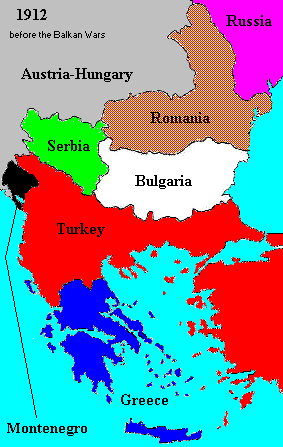 The map for 1912 gives us the situation right before the Balkan
Wars. Turkish holdings in Europe still extend all the way to the Adriatic,
including Albania which, although largely Moslem, has already been restless for
independence.
The map for 1912 gives us the situation right before the Balkan
Wars. Turkish holdings in Europe still extend all the way to the Adriatic,
including Albania which, although largely Moslem, has already been restless for
independence.
| 4. SERBIA & YUGOSLAVIA | |
|---|---|
| George Petrovic, Kara ("Black") George |
leads revolt, 1804-1813 |
| Milos Obrenovic | leads
revolt, 1815-1817; Prince, 1817-1839, 1858-1860 |
| Milan I | 1839 |
| Michael | 1839-1842, 1860-1868 |
| Alexander Karadjordjevic (Karageorgevich) |
1842-1858 |
| Milan II Obrenovic | 1868-1882 |
| King, 1882-1889 | |
| Alexander I | 1889-1903, murdered |
| Peter
I Karadjordjevic |
1903-1921 |
| King of Yugoslavia, 1919-1921 | |
| Alexander II | Regent, 1918-1921 |
| 1921-1934 | |
| Peter II | 1934-1945 |
| Paul | Regent, 1934-1941 |
| German & Italian Occupation, 1941-1943 | |
| German Occupation, 1943-1945 | |
| Communist takeover, 1945 | |
| Ivan Ribar | 1945-1953 |
| Josip Broz Tito | 1953-1980 |
| Lazar Kolisevski | 1980 |
| Cvijetin Mijatovic | 1980-1981 |
| Sergej Kraiger | 1981-1982 |
| Petar Stambolic | 1982-1983 |
| Mika Spiljak | 1983-1984 |
| Veselin Ðuranovic | 1984-1985 |
| Radovan Vlaikovic | 1985-1986 |
| Sinan Hasani | 1986-1987 |
| Lazar Mojsov | 1987-1988 |
| Raif Dizdarevic | 1988-1989 |
| Janez Drnovsek | 1989-1990 |
| Borisav Jovic | 1990-1991 |
| Stjepan Mesic | 1991 |
| Branko Kostic | 1991 |
| Dobrica Cosic | 1992-1993 |
| Zoran Lilic | 1993-1997 |
| Srdjan Bozovic | 1997 |
| Slobodan Milosevic | 1997-2000 |
| Vojislav Kostunica | 2000-present |
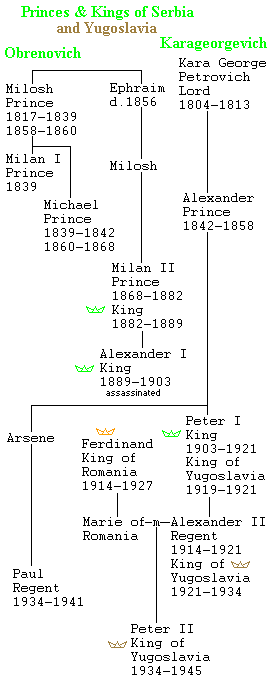
In
the shadow of the Napoleonic Wars and a Russian war with Turkey, Serbia began
the Balkan independence movement against Turkey with a long revolt that led to
an Ottoman grant of autonomy. The rivalry of the two leaders of the revolt,
Milosh Obrenovic and "Black" George Petrovic, however, led to a century of
sometimes bloodly conflict between their two families, culminating in a coup in
1903 when King Alexander I was murdered. The Congress of Vienna in 1878 granted
Serbia full independence, and the status of a Kingdom followed shortly.  The Serbian dream was not just to unite all Serbian speakers
remaining in Bosnia, Montenegro, Hungary, and Turkey, but all of the "Southern
Slavs," including the Croatians, Slovenians, and perhaps even Bulgarians. In the
aftermath of World War I, which began with the Serbian inspired assassination of
the Archduke Francis Ferdinand of Austria in Sarajevo, this dream was realized
in the establishment of Yugoslavia, which contained all the Southern
Slavs except for Bulgaria, which had its own fiercely separate traditions and
ambitions. Macedonia, however, had been wrested from Bulgaria in the Second
Balkan War (1913). These benefits were substantially due to the Russians, to
whom the Serbs looked as the protectors and patrons of the Orthodox Slavs. World
War I formally began when Russia declared war on Austria to protect the Serbs.
The flags of both Serbia and Yugoslavia are like the tricolor flag of Russia,
with just a different arrangement of the stripes.
The Serbian dream was not just to unite all Serbian speakers
remaining in Bosnia, Montenegro, Hungary, and Turkey, but all of the "Southern
Slavs," including the Croatians, Slovenians, and perhaps even Bulgarians. In the
aftermath of World War I, which began with the Serbian inspired assassination of
the Archduke Francis Ferdinand of Austria in Sarajevo, this dream was realized
in the establishment of Yugoslavia, which contained all the Southern
Slavs except for Bulgaria, which had its own fiercely separate traditions and
ambitions. Macedonia, however, had been wrested from Bulgaria in the Second
Balkan War (1913). These benefits were substantially due to the Russians, to
whom the Serbs looked as the protectors and patrons of the Orthodox Slavs. World
War I formally began when Russia declared war on Austria to protect the Serbs.
The flags of both Serbia and Yugoslavia are like the tricolor flag of Russia,
with just a different arrangement of the stripes.  The ethnic tensions between Orthodox Serbs and Catholic Slovenes and
Croatians (and others), however, manifested themselves both in World War II,
when the Germans found willing allies in the Croatians, and with the Fall of
Communism, when the growth of democracy unmasked the separatist hostilities
again. Yugoslavia broke up, with bitter fighting, atrocities, and "ethnic
cleansing" as the various communities and new states sought to secure territory.
The ethnic tensions between Orthodox Serbs and Catholic Slovenes and
Croatians (and others), however, manifested themselves both in World War II,
when the Germans found willing allies in the Croatians, and with the Fall of
Communism, when the growth of democracy unmasked the separatist hostilities
again. Yugoslavia broke up, with bitter fighting, atrocities, and "ethnic
cleansing" as the various communities and new states sought to secure territory.
| Former Yugoslav Republics |
|---|
| Slovenia |
| Croatia |
| Bosnia Herzegovina |
| Macedonia |
| Montenegro |
 The Balkan Wars all but eliminated Turkey in Europe. In the
First War (1912-1913), everyone attacked Turkey, which even lost Adrianople to
Bulgaria. Serbia was going to annex Albania, but the Great Powers required that
it become an independent state. The Serbs were not happy about that, and
Bulgaria wasn't happy about its share either. So the Second War (1913) featured
everyone against Bulgaria, which lost Macedonia to Serbia, Adrianople to Turkey,
and some territory south of the Danube to Romānia. Meanwhile, Italy had been at
war with Turkey in 1912 and had obtained Libya and, on this map, the Dodecanese
Islands.
The Balkan Wars all but eliminated Turkey in Europe. In the
First War (1912-1913), everyone attacked Turkey, which even lost Adrianople to
Bulgaria. Serbia was going to annex Albania, but the Great Powers required that
it become an independent state. The Serbs were not happy about that, and
Bulgaria wasn't happy about its share either. So the Second War (1913) featured
everyone against Bulgaria, which lost Macedonia to Serbia, Adrianople to Turkey,
and some territory south of the Danube to Romānia. Meanwhile, Italy had been at
war with Turkey in 1912 and had obtained Libya and, on this map, the Dodecanese
Islands.
| 5. BULGARIA | |
|---|---|
| Russo-Turkish War, 1876-1878 | |
| Alexander of Battenberg |
Prince, 1879-1886 |
| Ferdinand of Saxe-Coberg-Gotha |
Prince, 1887-1908 |
| King or Czar, 1908-1918 | |
| Boris III | 1918-1943 |
| Simeon II | 1943-1946 |
| Cyril | Regent, 1943-1944 |
| Communist takeover, 1946 | |
| Vasil Petrov Kolarov | 1946-1947 |
| Mintscho Naitschev | 1947-1950 |
| Georgi Damjanov | 1950-1958 |
| Dimitar Ganev | 1958-1964 |
| Georgi Traikov | 1964-1971 |
| Todor Schivkov | 1971-1989 |
| Petar Mladenov | 1989-1990 |
| Schelju Schelev | 1990-1997 |
| Petar Stojanov | 1997-2001 |
| Georgi Parvanov | 2001-present |
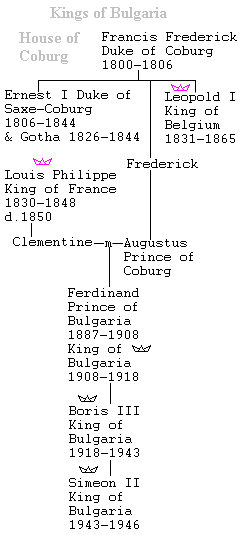
Bulgaria was the last of the mediaeval Balkan states to regain
complete independence from Turkey. Although usually regarded as a Kingdom,
rather more was implied when King Ferdinand (a second cousin of Edward VII of
England) also called himself "Tsar." He is actually supposed to have carried
around the vestments (obtained from a theatrical costumer) of a Roman
(/Byzantine) Emperor. This was no less than what most of the successor states
wanted, but the Bulgarians came closest to the physical heart of mediaeval
Romania in the First Balkan War (1912-1913) 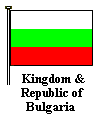 when they occupied Adrianople and drew near Constantinople. This
advantage, however, was lost in the Second Balkan War (1913), when Bulgaria took
on all the other belligerents from the First War, largely in a dispute with
Serbia over Macedonia (where a dialect or near relative of Bulgarian was
spoken), and was overwhelmingly defeated. Adrianople went back to Turkey,
Macedonia went to Serbia, and other territories went to Greece and Romania.
when they occupied Adrianople and drew near Constantinople. This
advantage, however, was lost in the Second Balkan War (1913), when Bulgaria took
on all the other belligerents from the First War, largely in a dispute with
Serbia over Macedonia (where a dialect or near relative of Bulgarian was
spoken), and was overwhelmingly defeated. Adrianople went back to Turkey,
Macedonia went to Serbia, and other territories went to Greece and Romania.  Still stinging from this defeat, Bulgaria threw its lot with Germany
in World War I, which cost it access to the Aegean Sea. The same strategy was
followed in World War II, where the wartime borders show us the Bulgarian wish
list, with gains from Serbia, Romania, and Greece (Turkey was not in the War).
The post-War settlement erased those gains, except against Romania, which had
also been a member of the Axis. Today Macedonia has broken away from Yugoslavia,
but to become independent rather than a part of Bulgaria. Note that the
numbering of Kings Boris III and Simeon II goes back to the original mediaeval
Bulgarian Tsars.
Still stinging from this defeat, Bulgaria threw its lot with Germany
in World War I, which cost it access to the Aegean Sea. The same strategy was
followed in World War II, where the wartime borders show us the Bulgarian wish
list, with gains from Serbia, Romania, and Greece (Turkey was not in the War).
The post-War settlement erased those gains, except against Romania, which had
also been a member of the Axis. Today Macedonia has broken away from Yugoslavia,
but to become independent rather than a part of Bulgaria. Note that the
numbering of Kings Boris III and Simeon II goes back to the original mediaeval
Bulgarian Tsars.
Mediaeval Bulgaria,
Qaghans & Tsars
Mediaeval Bulgaria,
Asens
Mediaeval
Bulgaria, Terters
Trouble over Bosnia began World War I, when a member of a Serbian "Black
Hand" assassination squad killed the Austrian Archduke Francis Ferdinand.
Austria ended up declaring war on Serbia, Russia on Austria, and Germany on
Russia. The Germans then, of course, invaded France, Russia's ally, and did so
through Belgium, violating recognized Belgian neutrality and bringing Britain
into the War. Turkey and Bulgaria, the losers of the Balkan Wars, sided with
Germany and Austria, while the other Balkan countries went with the Allies
(Greece reluctantly -- Queen Sophia was Kaiser Wilhelm's sister). The result was
losses for Bulgaria and gains for all the Allies, with Serbia orchestrating the
formation of Yugoslavia from Montenegro, Bosnia, Herzegovina, and other remants
of Austria-Hungary, Slovenia and Croatia. Romānia got Transylvania from Hungary
and also gains from Russia, which was distracted by the Russian Revolution and
Civil War. Bulgaria's loss of its Aegean coast would prove fortunate for the
region when it later went communist. However little Greece and Turkey liked each
other, it was convenient for them as Western allies to have a land frontier.
| 6. ALBANIA | |
|---|---|
| Ismail Kemal Bey | 1912-1914 |
| Wilhelm of Wied | King, 1914, d.1945 |
| Essad Pasha Toptani | 1914-1916 |
| Austrian Occupation, 1916-1918 | |
| Turchan Pasha | 1919-1920 |
| Regency Council, 1920-1924 | |
| Bishop Fan Noli | 1924 |
| Ahmet Zogu, Zog I |
1925-1928 |
| King, 1928-1939 d.1961 | |
| Italian & German Occupation, 1939-1943 | |
| Victor Emanuel (III) | King, 1939-1943 |
| German Occupation, 1943-1945 | |
| Communist takeover, Enver Hoxha Dictatorship, 1945-1985 | |
| Omer Nishani | 1946-1953 |
| Haji Leschi | 1953-1982 |
| Ramiz Alia | 1982-1992 |
| Sali Berisha | 1992-1997 |
| Rexhep Kemal Mejdani | 1997-present |
| Leka | Pretender, 1961-present |
Just about  the poorest and least educated people in Europe, the Albanians had
unexpected independence thrust upon them after the First Balkan War (1912-1913)
and then found themselves locked into paranoid and pauperized
the poorest and least educated people in Europe, the Albanians had
unexpected independence thrust upon them after the First Balkan War (1912-1913)
and then found themselves locked into paranoid and pauperized  isolation by a particularly nasty and megalomaniacal Communist regime
after World War II, under longtime Communist Party Chief Enver Hoxha.
After the schism between Comminist China and the Soviet Union, for many years
Albania was China's only international ally and supporter, regularly submitting
the PRC for membership in the United Nations. But eventually, after membership,
China began allowing Capitalism, and Albania had to retreat into its own
paranoid isolation as the last surviving Stalinist dictatorship. Since Hoxha
expected the Capitalists to invade at any time, the Albanian landscape became
covered with small bunkers, to defend every inch. The country, which had always
been poor anyway, became even poorer in Hoxha's grip, and it is nowhere near
even recovering, much less developing to the level of its European neighbors.
The Fall of Communism even witnessed large numbers of Albanians attempting to
flee to Italy by boat. Among the mysterious, autochthonous peoples of the
Balkans, the Albanians were strongly Latinized under Rome, Islamicized under
Turkey, coveted by Italy and Serbia, and include substantial communities in
Greece (denied by Greece, which officially has no ethnic minorities). Like a
number of peoples in the Balkans, they may not know just what to make of
themselves in the modern world, much less how their society is supposed to
function. Recent conspicuous Americans of Albanian heritage have been the
Belushis, John and his brother Jim, and Sandra
Bullock (whose mother is German and father, reportedly, of Albanian
derivation). One of John Belushi's memorable roles on Saturday Night Live
was in the ongoing "Greek Diner" skits. The Belushis, indeed, had run such a
diner in Chicago.
isolation by a particularly nasty and megalomaniacal Communist regime
after World War II, under longtime Communist Party Chief Enver Hoxha.
After the schism between Comminist China and the Soviet Union, for many years
Albania was China's only international ally and supporter, regularly submitting
the PRC for membership in the United Nations. But eventually, after membership,
China began allowing Capitalism, and Albania had to retreat into its own
paranoid isolation as the last surviving Stalinist dictatorship. Since Hoxha
expected the Capitalists to invade at any time, the Albanian landscape became
covered with small bunkers, to defend every inch. The country, which had always
been poor anyway, became even poorer in Hoxha's grip, and it is nowhere near
even recovering, much less developing to the level of its European neighbors.
The Fall of Communism even witnessed large numbers of Albanians attempting to
flee to Italy by boat. Among the mysterious, autochthonous peoples of the
Balkans, the Albanians were strongly Latinized under Rome, Islamicized under
Turkey, coveted by Italy and Serbia, and include substantial communities in
Greece (denied by Greece, which officially has no ethnic minorities). Like a
number of peoples in the Balkans, they may not know just what to make of
themselves in the modern world, much less how their society is supposed to
function. Recent conspicuous Americans of Albanian heritage have been the
Belushis, John and his brother Jim, and Sandra
Bullock (whose mother is German and father, reportedly, of Albanian
derivation). One of John Belushi's memorable roles on Saturday Night Live
was in the ongoing "Greek Diner" skits. The Belushis, indeed, had run such a
diner in Chicago.
As the Ottoman Empire declined in strength, and Christians
in the Balkans found European allies who favored their independence, like
Britain for Greece and Russia for Serbia, Romania, and Bulgaria, the Balkans
became the scene of one conflict after another. The Turks were not entirely out
of the picture until 1913, and this still left a number of the successor states,
especially Bulgaria and Serbia, not entirely happy with their shares. The Serbs
also pursued a grievance against Austria-Hungary, which inspired the
assassination of the Archduke Francis Ferdinand in 1914, precipitating World War
I. In the end the Serbs realized their dream of "Yugoslavia," the union of all
the "Southern Slavs." The dream of the Serbs, however, was not necessarily the
dream of all their fellow Yugoslavs. Macedonians really spoke a dialect of
Bulgarian, and would have been part of Bulgaria if the Bulgarians had had their
way. Slovenia, which historically had been part of Austria, and Croatia, which
historically had been part of Hungary, were divided from the Serbs by religion,
Catholicism versus Serbian Orthodoxy, and history, the Latin West versus the
Greek, Slavonic, and Turkish East, even though both the Serbs and Croatians
really spoke the same language -- Serbo-Croatian. Bosnia-Herzegovina was a messy
mixture of Serbs, Croatians, and those from both groups who had converted to
Islam during the long Turkish presence (the Bosniacs).
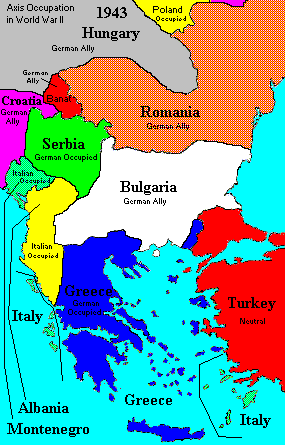 For a long time the jumble of ethnic groups in Yugoslavia didn't seem
to make too much difference. A preview of the future, however, was evident when
the Germans didn't have much trouble getting Croatians to kill Serbs and others
in World War II. The map at left shows the boundaries the way the Germans sorted
them out during the War. Hungary, Croatia, Romānia, and Bulgaria were all German
allies. Hungary, of course, wanted Transylvania back, but this would have to be
at the expense of another German ally, so Hitler compromised by giving Hungary a
part (the part with the most Hungarians) of Transylvania, but then compensated
Romānia with extra territory in the Ukraine (going off the map). Bulgaria got an
expanded Aegean coast and a major goal for some time, Macedonia. While Albania
was occupied by Italy, it was nevertheless expanded on what would have been
Albanian nationalist principles, with large pieces of Kosovo and Eprius. Banat
was a Romanian speaking region of Yugoslavia which, for some reason, was made
independent rather than ceded to Romānia. The Ionian Islands were directly
annexed to Italy, probably because they had belonged to Venice for some centuries.
The principle of Italian irredentism in the Adriatic was that any place that had
ever had an Italian name should belong to Italy.
For a long time the jumble of ethnic groups in Yugoslavia didn't seem
to make too much difference. A preview of the future, however, was evident when
the Germans didn't have much trouble getting Croatians to kill Serbs and others
in World War II. The map at left shows the boundaries the way the Germans sorted
them out during the War. Hungary, Croatia, Romānia, and Bulgaria were all German
allies. Hungary, of course, wanted Transylvania back, but this would have to be
at the expense of another German ally, so Hitler compromised by giving Hungary a
part (the part with the most Hungarians) of Transylvania, but then compensated
Romānia with extra territory in the Ukraine (going off the map). Bulgaria got an
expanded Aegean coast and a major goal for some time, Macedonia. While Albania
was occupied by Italy, it was nevertheless expanded on what would have been
Albanian nationalist principles, with large pieces of Kosovo and Eprius. Banat
was a Romanian speaking region of Yugoslavia which, for some reason, was made
independent rather than ceded to Romānia. The Ionian Islands were directly
annexed to Italy, probably because they had belonged to Venice for some centuries.
The principle of Italian irredentism in the Adriatic was that any place that had
ever had an Italian name should belong to Italy.
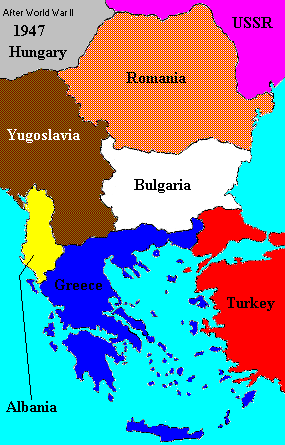 On the post-World War II map, Romānia has lost considerable
territory to the Soviet Union, including what Stalin took in 1940 (now Moldova),
and the territory that had been gotten from Bulgaria in 1913. Otherwise, pre-War
boundaries were restored. Marshall Tito (a Croat), after a successful Communist
insurgency against the Germans, got Yugoslavia put back together, broke with
Stalin, helped found the "unaligned" movement in the Cold War, and for many
years appeared to govern a happy and prosperous compromise between East and West
-- a favorite vacation destination for Europeans.
On the post-World War II map, Romānia has lost considerable
territory to the Soviet Union, including what Stalin took in 1940 (now Moldova),
and the territory that had been gotten from Bulgaria in 1913. Otherwise, pre-War
boundaries were restored. Marshall Tito (a Croat), after a successful Communist
insurgency against the Germans, got Yugoslavia put back together, broke with
Stalin, helped found the "unaligned" movement in the Cold War, and for many
years appeared to govern a happy and prosperous compromise between East and West
-- a favorite vacation destination for Europeans.
With the Fall of Communism, however, the whole business came unglued.
Slovenia, Croatia, Macedonia, and most Bosnians wanted to go their own way. The
dream of the Serbs crumbled, but their vision of destiny and grievance did not.
First they moved against Croatia, either as a preemptive attack or in
retaliation for the actions of the dictatorial Croatian leader, Franjo Tudjman,
against resident Serbs. It is now a little hard to determine who started it; but
the Serbs, tempted by military superiority, invaded in a way that looked more
like conquest than humanitarianism. Later, when the Serbs were tied up in Bosnia
and Croatia had built up its forces, Tudjman really did expel and massacre
Serbs, but the international community was already prepared to excuse or ignore
that as just retaliation. Both Serbia and Croatia, sometimes in
cooperation, then turned on Bosnia, which soon became a byword for massacre and
atrocities, including mass rapes, such had not been seen in the Balkans since
World War II. The Serbs, at the very least, handled their public relations very
poorly. Photos of emaciated prisoners in Serbian concentration camps immediately
lost them the international propaganda war. Although the Croatians and Bosniacs
certainly committed some atrocities themselves, the Serbian massacres seemed
larger, more blatant, and more insolent and defiant. While Tudjman might well
have been prosecuted as a war criminal (he is now dead), it has mainly been the
Serbs, and the former President of Serbia, Slobodan Milosevic, who have been the
targets of war crime prosecutions by the International Tribunal at the Hague.
While this has not been entirely fair to the Serbs, it does not excuse them from
what was indeed done. By whining about their own centuries of oppression, while
slaughtering Moslems, the Serbs managed to become some of the most
self-righteous war criminals within memory. Some NATO bombing, peacekeepers on
the ground, arrests, and war crimes trials finally put some kind of lid on the
conflict in Bosnia. But many guessed what was coming next. Because of the
Croatian offensive and version of "ethnic cleansing," some Serbs then fled all
the way to....Kosovo.
| 7. MACEDONIA | |
|---|---|
| Nikola Kljusev | 1991-1999 |
| Savo Klimovoski | 1999 |
| Boris Trajkovski | 1999-present |
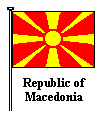 featured the "Star of Vergina," from the tomb of Philip II of
Macedon. This implied Macedonian designs on northern Greece, also containing
part of historic Macedonia; and indeed Macedonians did express some claims
there. I even saw stickers on lampposts in New York City proclaiming "Macedonia
is Greek!" What this was supposed to mean was not going to be obvious to anyone.
It made it sound like Greece itself had designs on the new Republic of
Macedonia. Did anyone even in New York City know, or care, what this was all
about? Probably not.
featured the "Star of Vergina," from the tomb of Philip II of
Macedon. This implied Macedonian designs on northern Greece, also containing
part of historic Macedonia; and indeed Macedonians did express some claims
there. I even saw stickers on lampposts in New York City proclaiming "Macedonia
is Greek!" What this was supposed to mean was not going to be obvious to anyone.
It made it sound like Greece itself had designs on the new Republic of
Macedonia. Did anyone even in New York City know, or care, what this was all
about? Probably not.
As it happened, Greece initially blocked admission of Macedonia to the United Nations. The flag was modified and the country is now usually referred to as the "Former Yugoslav Republic of Macedonia" (FYRM). Bulgaria seems to have given up claims to Macedonia, but I am still not clear whether Macedonian is or is not a dialect of Bulgaria. There are ways to determine this. Otherwise, the region has simply never been anything but "Macedonia."
I have received correspondence from a couple of Greeks disputing this, contending that the territory of the FYRM was never in historic Macedonia. Well, there is going to be considerable uncertainty about all ancient boundaries, and there is no telling how far Philip II's Macedonia extended north. Chances are it was well into FYRM territory (probably the whole valley of the Vardar/Axios River). Nevertheless, for Roman Macedonia the boundaries are better known. The capital of the FYRM, Skopje (Roman Scupi), was definitely in the early Roman province of Moesia Superior (later Dacia Mediterranea). However, the boundary of Moesia was immediately south of Skopje, which itself is quite close to the northern boundary of the FYRM. One map in the Atlas of the Roman World (Tim Cornell & John Matthews, Facts on File Publications, 1982, 1988, p.75) shows the bend of the Axius (Axios/Vardar) River, with Scupi on the north bank, as the actual northern boundary of Macedonia. Other maps (pp.141, 146) show some of the bend itself in Moesia, but this still leaves most of the territory of the FYRM in Roman Macedonia. The Roman cities of Stobi (near modern Stip), Lychnidus (modern Ohrid), and Heraclea Lyncestis (near modern Bitola) were all in Roman Macedonia and in the present FYRM. There is agreement on this in the Atlas of Classical History (Richard J.A. Talbert, Routledge, 1985, 1989, p.143).
For some, Macedonian claims to Greek Macedonia may be based on the
territorial integrity of the Macedonia of Philip II and on the presumed ethnic
identity of the modern Macedonians with the ancient. This kind of claim cannot
now be taken seriously, both because ancient boundaries are going to mean
nothing in modern international law and because the modern Macedonians speak a
 Slavic language which certainly has nothing to do with the (albeit
poorly attested) language of the ancient Macedonians. The other basis of
Macedonian claims, however, is more serious, and that concerns Macedonians
living in Greece. The Greeks deny that there is any such presence; but then
Greece officially denies that there are any ethnic minorities in Greece.
Linguistic maps of Greece in the 19th century show areas of speakers of
Albanian, Vlach, Macedonian, and even Turkish. The Anchor Atlas of World
History, Volume II (Hermann Kinder, Werner Hilgemann, Ernest A. Menze, and
Harald and Ruth Bukor, 1978) shows Macedonian speakers extending from
south of Skopje (Üsküp in Turkish, in a partially Albanian speaking area,
continguous with Kosovo) all the way down to Thessalonica (p.120). If there are
no longer Macedonian speakers in the modern Greek part of this area (only
acquired in 1913), then there is some explaining to do. If Greece expelled the
Macedonians, suppressed their language, or got them to leave through harassment
or oppressive policies, none of these are going to be admissions to the credit
of Greece, or admissions likely to be made, for just such a reason. At the very
least, the FYRM can reasonably ask for an accounting on this issue.
Slavic language which certainly has nothing to do with the (albeit
poorly attested) language of the ancient Macedonians. The other basis of
Macedonian claims, however, is more serious, and that concerns Macedonians
living in Greece. The Greeks deny that there is any such presence; but then
Greece officially denies that there are any ethnic minorities in Greece.
Linguistic maps of Greece in the 19th century show areas of speakers of
Albanian, Vlach, Macedonian, and even Turkish. The Anchor Atlas of World
History, Volume II (Hermann Kinder, Werner Hilgemann, Ernest A. Menze, and
Harald and Ruth Bukor, 1978) shows Macedonian speakers extending from
south of Skopje (Üsküp in Turkish, in a partially Albanian speaking area,
continguous with Kosovo) all the way down to Thessalonica (p.120). If there are
no longer Macedonian speakers in the modern Greek part of this area (only
acquired in 1913), then there is some explaining to do. If Greece expelled the
Macedonians, suppressed their language, or got them to leave through harassment
or oppressive policies, none of these are going to be admissions to the credit
of Greece, or admissions likely to be made, for just such a reason. At the very
least, the FYRM can reasonably ask for an accounting on this issue.
I am informed that Greeks would be happy with the FYRM simply being called
"Northern Macedonia."  This is a little silly and is not going to make any difference in any
Macedonian claims or possible threat against Greece. A parallel situation in
Europe is actually the relationship of Luxembourg to Belgium. When Belgium
became independent of the Netherlands in 1830, it took with it a very large part
of Luxembourg.
This is a little silly and is not going to make any difference in any
Macedonian claims or possible threat against Greece. A parallel situation in
Europe is actually the relationship of Luxembourg to Belgium. When Belgium
became independent of the Netherlands in 1830, it took with it a very large part
of Luxembourg. 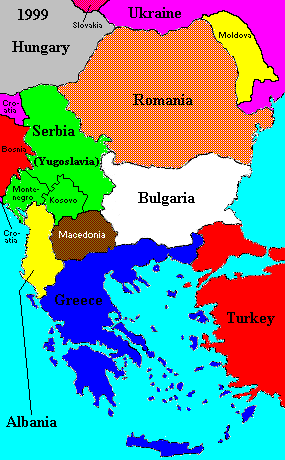 This area of Belgium is still called "Luxembourg." I have never
heard that Luxembourg, which itself became independent of the Netherlands in
1890, today makes any claims against Belgium. But even if it did, tiny
Luxembourg, although with the highest per capita income in the world,
would not constitute any kind of real threat. Poor and tiny Macedonia is not
going to constitute any more of a threat to Greece. If Macedonian guerrillas
were crossing over into Greece, this would be a matter of real concern and
complaint, but I do not understand that anything of the sort has happened; and
even if it did, Greece would have no difficulty knowing where to direct
counter-action.
This area of Belgium is still called "Luxembourg." I have never
heard that Luxembourg, which itself became independent of the Netherlands in
1890, today makes any claims against Belgium. But even if it did, tiny
Luxembourg, although with the highest per capita income in the world,
would not constitute any kind of real threat. Poor and tiny Macedonia is not
going to constitute any more of a threat to Greece. If Macedonian guerrillas
were crossing over into Greece, this would be a matter of real concern and
complaint, but I do not understand that anything of the sort has happened; and
even if it did, Greece would have no difficulty knowing where to direct
counter-action.
As it has happened, the problem of guerrillas has troubled the FYRM itself. Albanian refugees inundated northern Macedonia in 1999, where there was already, as noted, an Albanian community. With them came armed Albanians who, having lost in battle with the Serbs, were interested in "liberating" northern Macedonia. They succeeded no better there, but for a while there was considerable danger of a wider conflict. Meanwhile, Macedonia is the poorest of the former Yugoslav Republics, with a lower per capita income even than Albania. This puts it perilously close to being the poorest country in Europe -- though it is probably safe from that, since Moldova has a per capita income of not much over $300, while Macedonia's is more than $1500. "Room for improvement" hardly begins to tell the tale. The dispute over Macedonia's name and claims doesn't even begin to address the real problem economic development in the FYRM and elsewhere in the Balkans.
A major part of Serbia itself since 1913, the province of
Kosovo was only 10% Serb in population. Most of the rest were Albanian Moslems,
who had been deprived of the autonomy they had under the old Yugoslavia and were
now beginning to fight for independence through the radical Islamic "Kosova
Liberation Army" (KLA). What many observers expected, then, was that the Serbs
would turn the "ethnic cleansing" campaign made famous in Bosnia to the problem
of too many Albanians, especially rebellious Albanians, in Kosovo. With the UN
and the NATO allies already energized about Bosnia, simple defiance was not
going to work for the Serbs the way it might have if action had been taken
against Kosovo before all the events in Bosnia. Unfortunately, in modern Europe several wars have been fought between France
and Germany, Italy and Austria, Germany and Poland, etc., over many such
"historic" claims. Such things made a poor rationale for dictatorial and
terrorist measures, especially by an undemocratic country. When NATO decided to
move against Serbian measures in Kosovo in March 1999, we ended up with the next
round of the ongoing Balkans War. This time, however, the naked preference of
the Russians for the Orthodox Serbs over the Moslem Albanians, and similar
sentiments evidently shared by Greeks and others, left the Albanians with no
local friends at all. Albania itself has been a basket case of anarchy and
corruption almost the whole time since the end of Communism there. But the
outcome of such a conflict was very problematic when the NATO countries would
rather fight a quick, high tech war on the cheap, before body bags and anti-war
sentiment upsets things at home, while the Serbs, who learned their ruthlessness
from Marshal Tito, wanted nothing better than to appear as martyrs of America,
even while burning villages and driving people out of Kosovo. A century of war
thus ended more or less as it began, with Serbian grievance dragging others into
a war, while NATO, unable to commit on the ground, ended up bombing civilian
infrastructure in Serbia, contrary to international law, in a rapidly growing
"total war."
In June 1999, the Serbs finally gave in, after heavy bombing of Serbia
itself, and the Kosovars, driving out the remaining Serbs of Kosovo and
attempting to provoke an Albanian rising in Macedonia, have behaved more or less
the way the Serbs did. But Kosovo now seems headed for long term autonomy or
even independence.
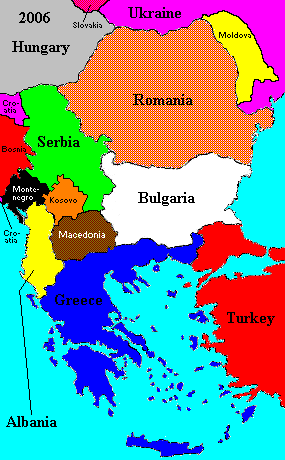 But defiance was the approach that the Serbs took, over a land to
which they emotionally claimed "historic rights," but which had mostly been
occupied by others since the 17th century and had been in Serbian hands only
since 1913. Although many Serbs now cite atrocities during World War II or say
there was even "ethnic cleansing" against them under Tito, their claim to Kosovo
is mainly as part of "historic" (i.e. 14th century) Serbia.
But defiance was the approach that the Serbs took, over a land to
which they emotionally claimed "historic rights," but which had mostly been
occupied by others since the 17th century and had been in Serbian hands only
since 1913. Although many Serbs now cite atrocities during World War II or say
there was even "ethnic cleansing" against them under Tito, their claim to Kosovo
is mainly as part of "historic" (i.e. 14th century) Serbia.
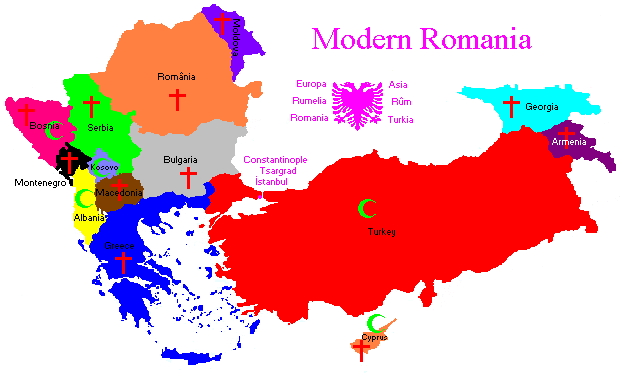
Copyright (c) 1999, 2000, 2001, 2002, 2003, 2004, 2005, 2006, 2007 Kelley L. Ross, Ph.D. All Rights Reserved